Paul van Yperen's Blog, page 37
September 30, 2024
Jack Mulhall
American actor Jack Mulhall (1887-1979) was a film star of the silent film era. His cinematic oeuvre includes more than 450 film and television productions between 1910 and 1959.
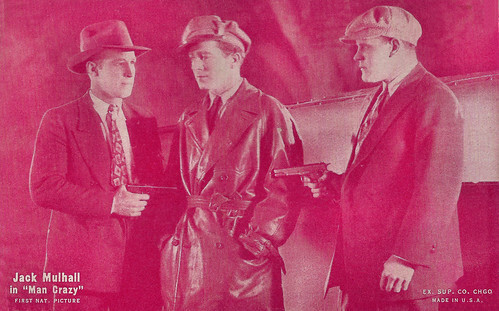
American Arcade card by Ex. Sup. Co, Chicago. Photo: First National. Jack Mulhall in Man Crazy (John Francis Dillon, 1927).
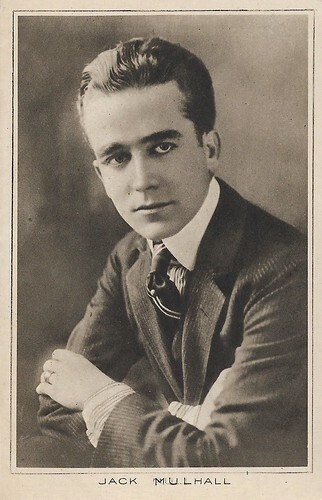
British postcard. in the "Pictures" Portrait Gallery, London, no. 25. Photo: The Trans-Atlantic Film Co. (Universal's European distribution brand).
A film star of the Roaring Twenties
Jack Mulhall was born John Joseph Francis Mulhall in 1887 in Wappingers Falls, New York. Mulhall began his career as a singer in the circus as a teenager, after which he worked his way up to become a serious actor with appearances in Vaudeville shows and travelling theatre groups.
The first film appearances of Mulhall, then in his early twenties, are documented for the year 1910 at the Biograph Company. There, David Wark Griffith was making films that were groundbreaking in terms of film technology at the time. Mulhall acted e.g. in a minor part in his The Fugitive (David Wark Griffith, 1910). From the mid-1910s, Mulhall was established as a leading actor in films and achieved corresponding popularity.
Around 1916 he started at Universal. There he starred in various films with Lon Chaney and Dorothy Phillips, such as The Place Beyond the Winds (Joe De Grasse, 1916) and The Price of Silence (Joe De Grasse, 1916). He also co-starred with Ruth Stonehouse in such films as Love Aflame (James Vincent, Raymond Wells, 1917) and The Saintly Sinner (Raymond Wells, 1917). In addition to drama, Mulhall also starred in Westerns and comedy, fantasy, and crime films. In 1918 he starred opposite Juanita Hansen in the Universal serial The Brassed Bullet (Ben F. Wilson, 1918).
From 1919, Jack Mulhall filmed for several years for the Metro Pictures Corporation, from which Metro-Goldwyn-Mayer later emerged. He also worked for Paramount, First National, Universal, and several minor companies. He increasingly appeared in elaborately produced feature films instead of short films. Examples are the Metro production Fools and Their Money (Herbert Blaché, 1919), and the Paramount film You Never Can Tell (Chester Franklin, 1920) with Bebe Daniels .
Mulhall became a film star of the Roaring Twenties with popular films such as the Universal serial The Social Buccaneer (Robert F. Hill, 1923) with Margaret Livingston , Universal's jazz age feature The Mad Whirl (William Seiter, 1925) with Mae McAvoy , and the Colleen Moore comedies We Moderns (John Francis Dillon, 1925) and Orchids and Ermine (Alfred Santell, 1925) for First National.
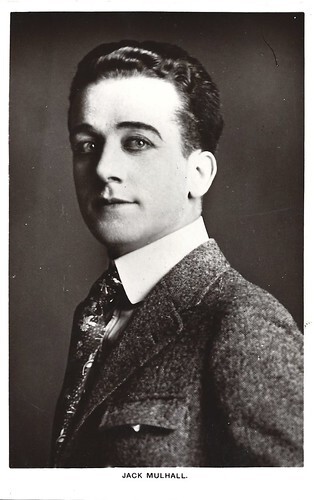
British postcard in the Picturegoer series, London, no. 164.
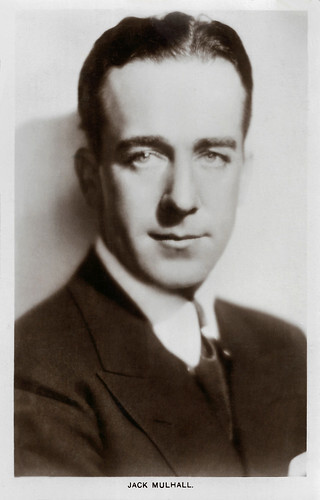
British postcard in the Picturegoer Series, London, no. 164b.
The elegant man of the world
Jack Mulhall often played the elegant man of the world, particularly in several light comedies with Dorothy Mackaill as his film partner. These included the First National comedies Joanna (Edwin Carewe, 1925), Man Crazy (John Francis Dillon, 1927), and Lady Be Good (Richard Wallace, 1928). He also appeared in dramas like Waterfront (William A. Seiter, 1928). Mulhall's other film partners of the 1920s included Constance Binney, Florence Vidor , Lois Wilson , Constance Talmadge , Norma Talmadge , Alma Rubens , Lois Moran, Greta Nissen , Lila Lee , Alice White , Billie Dove and Corinne Griffith . According to his obituary in The New York Times, he was the first male actor in Hollywood to earn $1,000 a week. He also appeared in several Westerns. He was the lead actor in the Jack London film The Call of the Wild (Fred Jackman, 1923) and starred in the Western serial, Wild West (Robert F. Hill, 1925).
With the advent of sound film at the end of the 1920s, Jack Mulhall was initially cast in leading roles thanks to his pleasant voice. He appeared in such musicals as Show Girl in Hollywood (Mervyn LeRoy, 1930) with Alice White , The Fall Guy (Leslie Pearce, 1930) with Mae Clarke, and Lover Come Back To Me (Erle C. Kenton, 1931) with Constance Cummings and Betty Bronson .
Yet, his popularity waned just a few years later. From the mid-1930s onwards, he only made major appearances in B movies and film serials. He often remained unnamed in the credits for his small supporting roles in high-calibre film productions. He lost large parts of his fortune, estimated at over a million dollars, in the stock market crash of 1929 and the subsequent Great Depression. Mulhall took the fall of his career in stride but is said to have been puzzled by it until his death. ‘I guess actors can't be good businessmen’, he once commented on his bad investments.
Jack Mulhall's more notable roles in the sound film era include his appearances in film serials. He played the lead role in Burn ‘Em Up Barnes (Colbert Clark, Armand Schaefer, 1934) and subsequently had supporting roles in the Buster Crabbe serials Flash Gordon's Trip to Mars (Ford Beebe, Robert F. Hill, Frederick Stephani, 1938) and Buck Rogers (Ford Beebe, Saul A. Goodkind, 1939). However, in most of his later films, he only made brief appearances. He was often cast as a policeman, reporter or doctor. he was also heard on US radio from the 1930s onward and appeared in 'Blackouts', a successful stage revue by Ken Murray, in the late 1940s.
After appearing in the new medium of television, Mulhall, now over 70 years old, retired from the film business after the film The Atomic Submarine (Spencer Gordon Bennett, 1959). The film veteran remained active as a contract negotiator and representative for the Screen Actors Guild until 1974. Mulhall married his first wife Bertha Vuillot in 1909, but she died young. He married his second wife Laura Bunton in 1916 and they had a son, John. Laura committed suicide in 1921. He married his third wife Evelyn Mulhall in 1922. Mulhall died in 1979 at the age of 91 in the Motion Picture & Television Country House, where he had moved two years before his death. In 1960, a star on the Hollywood Walk of Fame was dedicated to him.
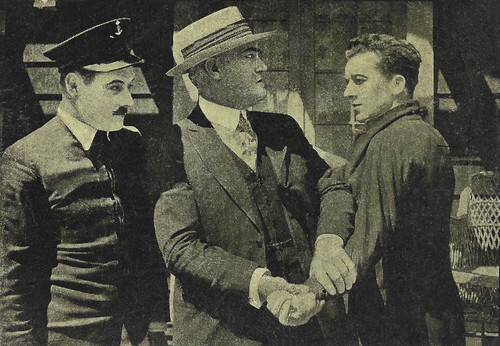
Spanish collector card by Chocolate Pi, Barcelona, no. 7 of 54. Photo: Trans-Atlantic Film Co. / Distr. J. Verdaguer, Barcelona. Scene from the American serial The Brass Bullet (Ben F. Wilson, Universal 1918), starring Jack Mulhall and Juanita Hansen. Spanish release title: La Bala de Bronce.
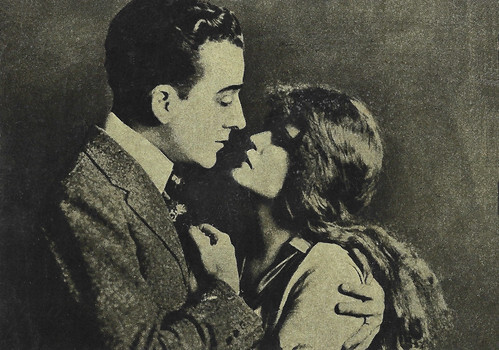
Spanish collector card by Chocolate Pi, Barcelona, no. 23 of 54. Photo: Trans-Atlantic Film Co. / Distr. J. Verdaguer, Barcelona. Jack Mulhall and Juanita Hansen in The Brass Bullet (Ben F. Wilson, 1918). Spanish release title: La Bala de Bronce.
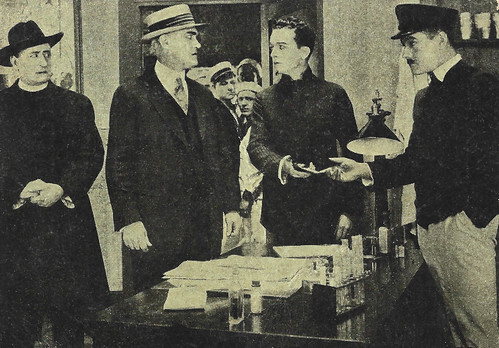
Spanish collector card by Chocolate Pi, Barcelona, no. 32 of 54. Photo: Trans-Atlantic Film Co. / Distr. J. Verdaguer, Barcelona. Scene from the American serial The Brass Bullet (Ben F. Wilson, 1918).Spanish release title: La Bala de Bronce. Here, left of Jack Mulhall, possibly Joseph W. Girard as Spring Gilbert. The minister left of him was played by Charles Force. The man on the right may be Ashton Dearholt, who plays Victor King.
Sources: Wikipedia (German and English) and .

American Arcade card by Ex. Sup. Co, Chicago. Photo: First National. Jack Mulhall in Man Crazy (John Francis Dillon, 1927).

British postcard. in the "Pictures" Portrait Gallery, London, no. 25. Photo: The Trans-Atlantic Film Co. (Universal's European distribution brand).
A film star of the Roaring Twenties
Jack Mulhall was born John Joseph Francis Mulhall in 1887 in Wappingers Falls, New York. Mulhall began his career as a singer in the circus as a teenager, after which he worked his way up to become a serious actor with appearances in Vaudeville shows and travelling theatre groups.
The first film appearances of Mulhall, then in his early twenties, are documented for the year 1910 at the Biograph Company. There, David Wark Griffith was making films that were groundbreaking in terms of film technology at the time. Mulhall acted e.g. in a minor part in his The Fugitive (David Wark Griffith, 1910). From the mid-1910s, Mulhall was established as a leading actor in films and achieved corresponding popularity.
Around 1916 he started at Universal. There he starred in various films with Lon Chaney and Dorothy Phillips, such as The Place Beyond the Winds (Joe De Grasse, 1916) and The Price of Silence (Joe De Grasse, 1916). He also co-starred with Ruth Stonehouse in such films as Love Aflame (James Vincent, Raymond Wells, 1917) and The Saintly Sinner (Raymond Wells, 1917). In addition to drama, Mulhall also starred in Westerns and comedy, fantasy, and crime films. In 1918 he starred opposite Juanita Hansen in the Universal serial The Brassed Bullet (Ben F. Wilson, 1918).
From 1919, Jack Mulhall filmed for several years for the Metro Pictures Corporation, from which Metro-Goldwyn-Mayer later emerged. He also worked for Paramount, First National, Universal, and several minor companies. He increasingly appeared in elaborately produced feature films instead of short films. Examples are the Metro production Fools and Their Money (Herbert Blaché, 1919), and the Paramount film You Never Can Tell (Chester Franklin, 1920) with Bebe Daniels .
Mulhall became a film star of the Roaring Twenties with popular films such as the Universal serial The Social Buccaneer (Robert F. Hill, 1923) with Margaret Livingston , Universal's jazz age feature The Mad Whirl (William Seiter, 1925) with Mae McAvoy , and the Colleen Moore comedies We Moderns (John Francis Dillon, 1925) and Orchids and Ermine (Alfred Santell, 1925) for First National.

British postcard in the Picturegoer series, London, no. 164.

British postcard in the Picturegoer Series, London, no. 164b.
The elegant man of the world
Jack Mulhall often played the elegant man of the world, particularly in several light comedies with Dorothy Mackaill as his film partner. These included the First National comedies Joanna (Edwin Carewe, 1925), Man Crazy (John Francis Dillon, 1927), and Lady Be Good (Richard Wallace, 1928). He also appeared in dramas like Waterfront (William A. Seiter, 1928). Mulhall's other film partners of the 1920s included Constance Binney, Florence Vidor , Lois Wilson , Constance Talmadge , Norma Talmadge , Alma Rubens , Lois Moran, Greta Nissen , Lila Lee , Alice White , Billie Dove and Corinne Griffith . According to his obituary in The New York Times, he was the first male actor in Hollywood to earn $1,000 a week. He also appeared in several Westerns. He was the lead actor in the Jack London film The Call of the Wild (Fred Jackman, 1923) and starred in the Western serial, Wild West (Robert F. Hill, 1925).
With the advent of sound film at the end of the 1920s, Jack Mulhall was initially cast in leading roles thanks to his pleasant voice. He appeared in such musicals as Show Girl in Hollywood (Mervyn LeRoy, 1930) with Alice White , The Fall Guy (Leslie Pearce, 1930) with Mae Clarke, and Lover Come Back To Me (Erle C. Kenton, 1931) with Constance Cummings and Betty Bronson .
Yet, his popularity waned just a few years later. From the mid-1930s onwards, he only made major appearances in B movies and film serials. He often remained unnamed in the credits for his small supporting roles in high-calibre film productions. He lost large parts of his fortune, estimated at over a million dollars, in the stock market crash of 1929 and the subsequent Great Depression. Mulhall took the fall of his career in stride but is said to have been puzzled by it until his death. ‘I guess actors can't be good businessmen’, he once commented on his bad investments.
Jack Mulhall's more notable roles in the sound film era include his appearances in film serials. He played the lead role in Burn ‘Em Up Barnes (Colbert Clark, Armand Schaefer, 1934) and subsequently had supporting roles in the Buster Crabbe serials Flash Gordon's Trip to Mars (Ford Beebe, Robert F. Hill, Frederick Stephani, 1938) and Buck Rogers (Ford Beebe, Saul A. Goodkind, 1939). However, in most of his later films, he only made brief appearances. He was often cast as a policeman, reporter or doctor. he was also heard on US radio from the 1930s onward and appeared in 'Blackouts', a successful stage revue by Ken Murray, in the late 1940s.
After appearing in the new medium of television, Mulhall, now over 70 years old, retired from the film business after the film The Atomic Submarine (Spencer Gordon Bennett, 1959). The film veteran remained active as a contract negotiator and representative for the Screen Actors Guild until 1974. Mulhall married his first wife Bertha Vuillot in 1909, but she died young. He married his second wife Laura Bunton in 1916 and they had a son, John. Laura committed suicide in 1921. He married his third wife Evelyn Mulhall in 1922. Mulhall died in 1979 at the age of 91 in the Motion Picture & Television Country House, where he had moved two years before his death. In 1960, a star on the Hollywood Walk of Fame was dedicated to him.

Spanish collector card by Chocolate Pi, Barcelona, no. 7 of 54. Photo: Trans-Atlantic Film Co. / Distr. J. Verdaguer, Barcelona. Scene from the American serial The Brass Bullet (Ben F. Wilson, Universal 1918), starring Jack Mulhall and Juanita Hansen. Spanish release title: La Bala de Bronce.

Spanish collector card by Chocolate Pi, Barcelona, no. 23 of 54. Photo: Trans-Atlantic Film Co. / Distr. J. Verdaguer, Barcelona. Jack Mulhall and Juanita Hansen in The Brass Bullet (Ben F. Wilson, 1918). Spanish release title: La Bala de Bronce.

Spanish collector card by Chocolate Pi, Barcelona, no. 32 of 54. Photo: Trans-Atlantic Film Co. / Distr. J. Verdaguer, Barcelona. Scene from the American serial The Brass Bullet (Ben F. Wilson, 1918).Spanish release title: La Bala de Bronce. Here, left of Jack Mulhall, possibly Joseph W. Girard as Spring Gilbert. The minister left of him was played by Charles Force. The man on the right may be Ashton Dearholt, who plays Victor King.
Sources: Wikipedia (German and English) and .
Published on September 30, 2024 22:00
September 29, 2024
La Collectionneuse: Mitzi Green
Mitzi Green made her first steps on stage at age 3 and, within a few years, was featured in her own vaudeville act. She later became a child star in films. When pitted against such scene stealers as Zasu Pitts, Leon Erroll, Edna May Oliver, Louise Fazenda or Wheeler and Wolsey, she more than held her own. A seasoned trouper from an early age, she knew how not to be overshadowed. As was the case for many child stars, her movie career declined as she reached adolescence. But it was not a problem for Mitzi, who would bounce back on stage. She was also happy in her private life: in 1942, she married Joseph Pevney, who would later become a noted movie and TV director, and they had four children.
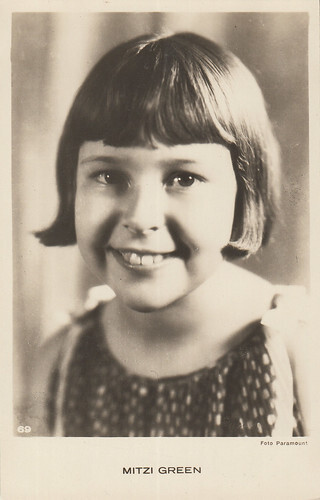
Dutch postcard, no. 69. Photo: Paramount.
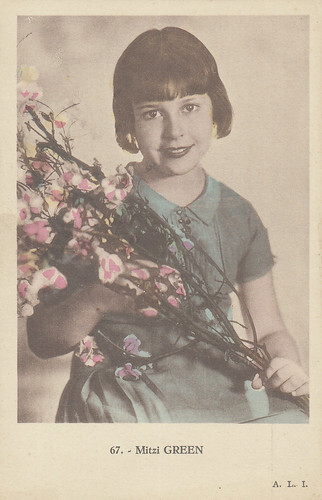
Dutch postcard by A.L.I., no. 67.
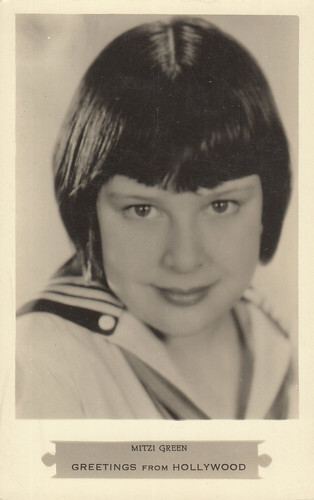
American postcard in the 'Greetings from Hollywood' series.
A child prodigy
Mitzi Green was born on the 22nd of October 1920 in New York, U.S.A. Her parents were vaudevillians Joe Keno and Rosie Green.
According to an interview she gave in June 1930 to the newspaper The American Jewish World, she made her stage debut when famous artist Gus Edwards put her in one of his sketches at age 3.
When she was 4 years old, the stage-struck little girl begged her father to take her into his act. He relented and she was allowed to give a successful imitation of vaudeville stars Sadie Burt and George Whiting. It was a short-lived experience as her parents next sent her to public school.
At age 6, she performed at a benefit performance and did an imitation of Moran and Mack, a duo known for their popular black-face comedy act. She was noticed by a booker from the Interstate Theatre Circuit who offered to sign her as a headliner. Her father accepted, provided that she would continue her studies with a private teacher.
Later, she went on the Orpheum Circuit. At that time, she was known as 'Little Mitzi, The Child Mimic'. At the end of the 1920s, she played at the Orpheum Theatre in Los Angeles. Paramount liked her act and hired her.
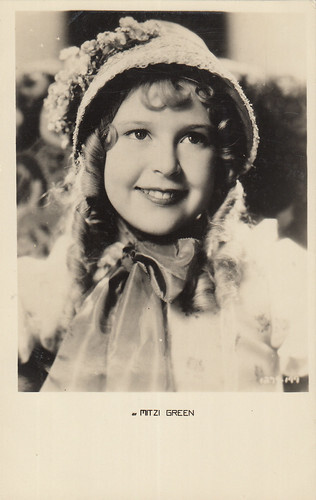
Dutch postcard, no. 511. Mitzi Green in Tom Sawyer (John Cromwell, 1930).
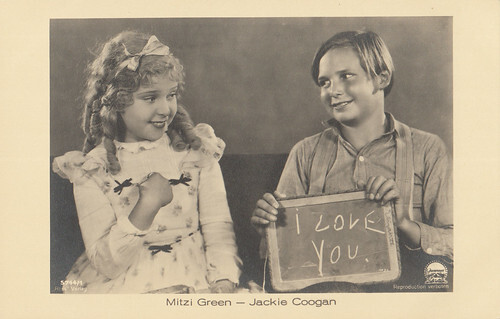
German postcard by Ross Verlag, no. 5744/1, 1930-1931. Photo: Paramount. Mitzi Green and Jackie Coogan in Tom Sawyer (John Cromwell, 1930).
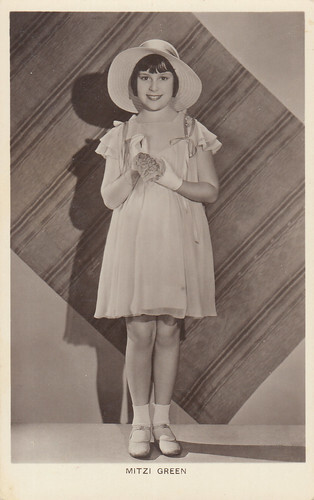
British postcard in the Picturegoer Series, London, no. 546.
Movie star
Mitzi Green made her screen debut as Mary Brian ’s impish half-sister in The Marriage Playground ((1929). The Dutch-bobbed little girl quickly caught on with movie audiences and became one of the foremost child stars of her time.
In 1930, as Zasu Pitts’ bratty daughter, she had the opportunity to sing an excerpt of the standard 'Sing You Sinners' in one of Honey‘s musical numbers.In the all-star musical revue Paramount on Parade (1930), she imitated Maurice Chevalier and the duo Moran and Mack. Love Among The Millionaires (1930), The Santa Fe Trail (1930), Finn and Hattie (1931), Skippy (1931), Dude Ranch (1931) and Newly Rich/Forbidden Adventure (1931) followed.
She also played Becky Thatcher in Tom Sawyer (1930) and Huckleberry Finn (1931). In the star-studded short The Stolen Jools (1931), sponsored by Chesterfield Cigarettes to raise funds for a tuberculosis charity, she solved the mystery of Norma Shearer ’s robbed jewels. Mitzi Green’s screen persona was not that of the usual sweet and loving little girl and, in several of her films, she played mischievous, vivacious or misbehaving youngsters.
After her stay at Paramount, she starred in two R.K.O. movies. In Girl Crazy (1932), from a successful George and Ira Gershwin Broadway musical, she played Bert Wheeler ’s annoying little sister and imitated Bing Crosby, Roscoe Ates, George Arliss and Edna May Oliver, while singing 'But Not for Me'.
Next came the title role in Little Orphan Annie (1932), an adaptation of a popular comic strip, in which she gave imitations of the Marx Brothers . Unfortunately, she soon reached an age when she couldn’t play little girls anymore. The public discovered a grown-up Mitzi in the film Transatlantic Merry-Go-Round (1934). The former child prodigy had a musical number in which she impersonated George Arliss . Eighteen years would pass before she appeared in another film.
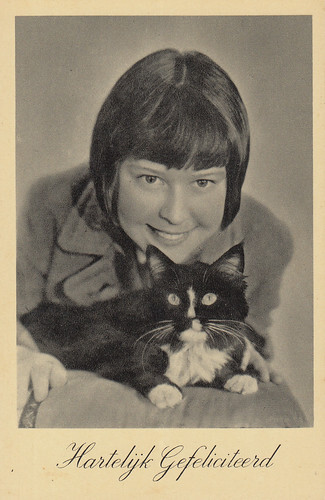
Dutch postcard.
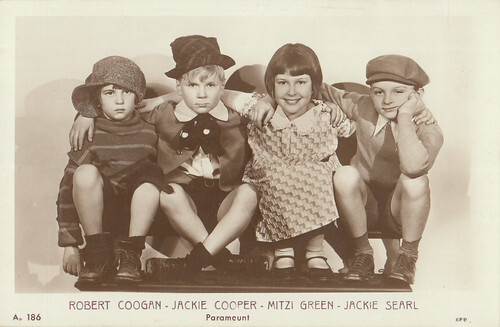
Spanish postcard by Editorial Fotografica, Barcelona, no. A.186. Photo: Paramount. Mitzi Green, Robert Coogan, Jackie Cooper and Jackie Searl in Skippy (Norman Taurog, 1931).
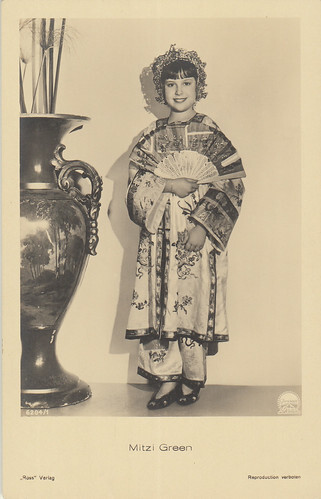
German postcard by Ross Verlag, no. 6204/1, 1931-1932.
Back to the stage
Having outlived her movie fame, Mitzi Green went back to live performing. In 1936, she played at the posh Versailles nightclub in New York.
From April to December 1937, she starred on Broadway in the successful Rodgers and Hart musical 'Babes In Arms', in which she introduced the famous tunes 'My Funny Valentine' and 'The Lady Is a Tramp'.
For the 1939 film version, M.G.M. replaced Mitzi Green and Ray Heatherton with their two top young stars, Judy Garland and Mickey Rooney .
Her next two Broadway appearances were not hits: 'Walk With Music' in 1940 and 'Let Freedom Sing' in 1942 respectively closed after 55 and 8 performances.
But she bounced back with Betty Comden and Adolph Green’s musical 'Billion Dollar Baby', which ran from December 1945 to June 1946.
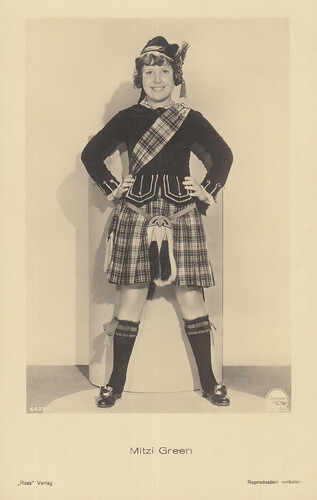
German postcard by Ross Verlag, no. 6408/1, 1931-1932. Photo: Paramount.
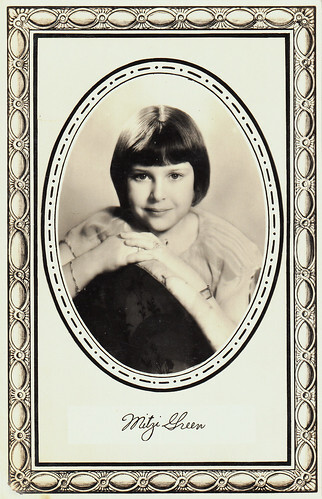
British postcard in the Autograph Series, London, no. A34.
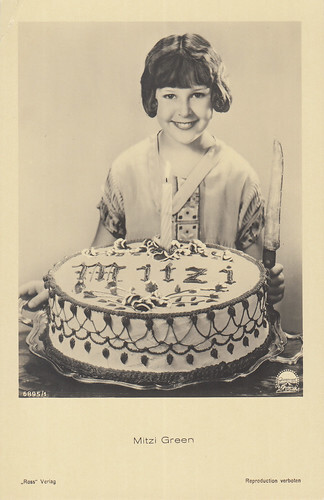
German postcard by Ross Verlag, no. 6895/1, 1931-1932. Photo: Paramount.
A versatile performer
In 1946, Mitzi Green starred in the radio show 'Passport to Romance'.
Night clubs, notably the Copacabana in New York, regularly booked her and she continued to add new imitations to her repertoire, such as cabaret singer Hildegarde.
She made a short-lived screen come-back as Abbott and Costello’s co-star in Lost in Alaska (1952) and in a good supporting part in Bloodhounds of Broadway (1952).
She also played a stuntwoman in the TV series So This is Hollywood in 1955. At the beginning of the 1960s, she toured with the musical 'Gypsy'.
Mitzi Green died of cancer on the 24th of May 1969.
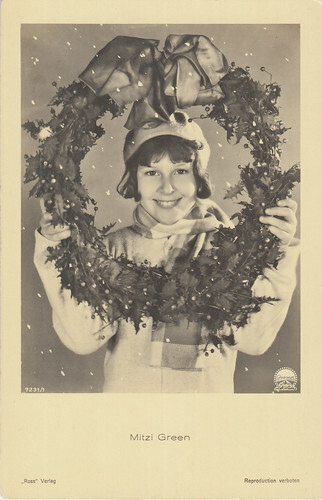
German postcard by Ross Verlag, no. 7231/1, 1932-1933. Photo: Paramount.
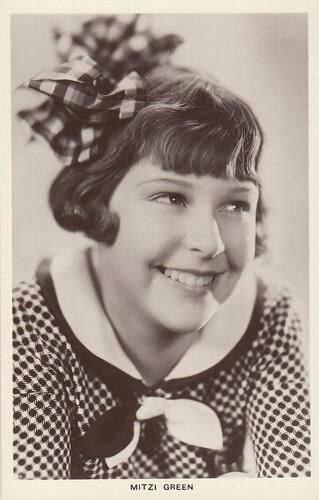
British postcard in the Picturegoer Series, London, no. 546a.
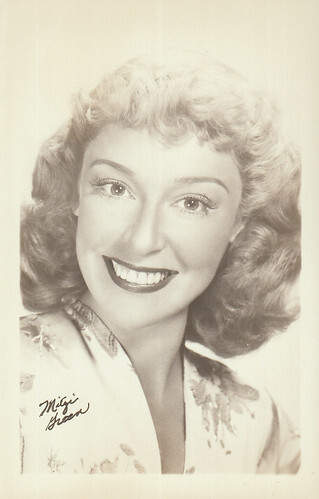
American postcard.
Text and postcards: Marlene Pilaete.

Dutch postcard, no. 69. Photo: Paramount.

Dutch postcard by A.L.I., no. 67.

American postcard in the 'Greetings from Hollywood' series.
A child prodigy
Mitzi Green was born on the 22nd of October 1920 in New York, U.S.A. Her parents were vaudevillians Joe Keno and Rosie Green.
According to an interview she gave in June 1930 to the newspaper The American Jewish World, she made her stage debut when famous artist Gus Edwards put her in one of his sketches at age 3.
When she was 4 years old, the stage-struck little girl begged her father to take her into his act. He relented and she was allowed to give a successful imitation of vaudeville stars Sadie Burt and George Whiting. It was a short-lived experience as her parents next sent her to public school.
At age 6, she performed at a benefit performance and did an imitation of Moran and Mack, a duo known for their popular black-face comedy act. She was noticed by a booker from the Interstate Theatre Circuit who offered to sign her as a headliner. Her father accepted, provided that she would continue her studies with a private teacher.
Later, she went on the Orpheum Circuit. At that time, she was known as 'Little Mitzi, The Child Mimic'. At the end of the 1920s, she played at the Orpheum Theatre in Los Angeles. Paramount liked her act and hired her.

Dutch postcard, no. 511. Mitzi Green in Tom Sawyer (John Cromwell, 1930).

German postcard by Ross Verlag, no. 5744/1, 1930-1931. Photo: Paramount. Mitzi Green and Jackie Coogan in Tom Sawyer (John Cromwell, 1930).

British postcard in the Picturegoer Series, London, no. 546.
Movie star
Mitzi Green made her screen debut as Mary Brian ’s impish half-sister in The Marriage Playground ((1929). The Dutch-bobbed little girl quickly caught on with movie audiences and became one of the foremost child stars of her time.
In 1930, as Zasu Pitts’ bratty daughter, she had the opportunity to sing an excerpt of the standard 'Sing You Sinners' in one of Honey‘s musical numbers.In the all-star musical revue Paramount on Parade (1930), she imitated Maurice Chevalier and the duo Moran and Mack. Love Among The Millionaires (1930), The Santa Fe Trail (1930), Finn and Hattie (1931), Skippy (1931), Dude Ranch (1931) and Newly Rich/Forbidden Adventure (1931) followed.
She also played Becky Thatcher in Tom Sawyer (1930) and Huckleberry Finn (1931). In the star-studded short The Stolen Jools (1931), sponsored by Chesterfield Cigarettes to raise funds for a tuberculosis charity, she solved the mystery of Norma Shearer ’s robbed jewels. Mitzi Green’s screen persona was not that of the usual sweet and loving little girl and, in several of her films, she played mischievous, vivacious or misbehaving youngsters.
After her stay at Paramount, she starred in two R.K.O. movies. In Girl Crazy (1932), from a successful George and Ira Gershwin Broadway musical, she played Bert Wheeler ’s annoying little sister and imitated Bing Crosby, Roscoe Ates, George Arliss and Edna May Oliver, while singing 'But Not for Me'.
Next came the title role in Little Orphan Annie (1932), an adaptation of a popular comic strip, in which she gave imitations of the Marx Brothers . Unfortunately, she soon reached an age when she couldn’t play little girls anymore. The public discovered a grown-up Mitzi in the film Transatlantic Merry-Go-Round (1934). The former child prodigy had a musical number in which she impersonated George Arliss . Eighteen years would pass before she appeared in another film.

Dutch postcard.

Spanish postcard by Editorial Fotografica, Barcelona, no. A.186. Photo: Paramount. Mitzi Green, Robert Coogan, Jackie Cooper and Jackie Searl in Skippy (Norman Taurog, 1931).

German postcard by Ross Verlag, no. 6204/1, 1931-1932.
Back to the stage
Having outlived her movie fame, Mitzi Green went back to live performing. In 1936, she played at the posh Versailles nightclub in New York.
From April to December 1937, she starred on Broadway in the successful Rodgers and Hart musical 'Babes In Arms', in which she introduced the famous tunes 'My Funny Valentine' and 'The Lady Is a Tramp'.
For the 1939 film version, M.G.M. replaced Mitzi Green and Ray Heatherton with their two top young stars, Judy Garland and Mickey Rooney .
Her next two Broadway appearances were not hits: 'Walk With Music' in 1940 and 'Let Freedom Sing' in 1942 respectively closed after 55 and 8 performances.
But she bounced back with Betty Comden and Adolph Green’s musical 'Billion Dollar Baby', which ran from December 1945 to June 1946.

German postcard by Ross Verlag, no. 6408/1, 1931-1932. Photo: Paramount.

British postcard in the Autograph Series, London, no. A34.

German postcard by Ross Verlag, no. 6895/1, 1931-1932. Photo: Paramount.
A versatile performer
In 1946, Mitzi Green starred in the radio show 'Passport to Romance'.
Night clubs, notably the Copacabana in New York, regularly booked her and she continued to add new imitations to her repertoire, such as cabaret singer Hildegarde.
She made a short-lived screen come-back as Abbott and Costello’s co-star in Lost in Alaska (1952) and in a good supporting part in Bloodhounds of Broadway (1952).
She also played a stuntwoman in the TV series So This is Hollywood in 1955. At the beginning of the 1960s, she toured with the musical 'Gypsy'.
Mitzi Green died of cancer on the 24th of May 1969.

German postcard by Ross Verlag, no. 7231/1, 1932-1933. Photo: Paramount.

British postcard in the Picturegoer Series, London, no. 546a.

American postcard.
Text and postcards: Marlene Pilaete.
Published on September 29, 2024 22:00
September 28, 2024
La casa di vetro (1920)
Maria Jacobini and Amleto Novelli star in the Italian silent melodrama La casa di vetro/The Glass House (Gennaro Righelli, 1920). G.B. Falci in Milan published the postcards.
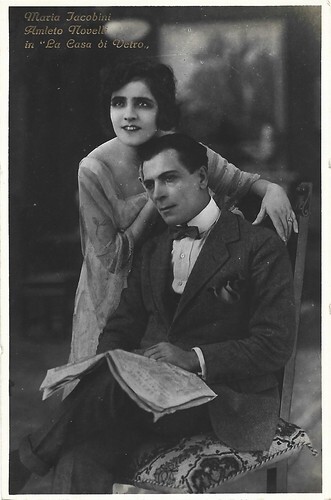
Italian postcard by G.B. Falci, Milano. Photo: publicity still for La casa di vetro/The Glass House (Gennaro Righelli, 1920), starring Maria Jacobini and Amleto Novelli .
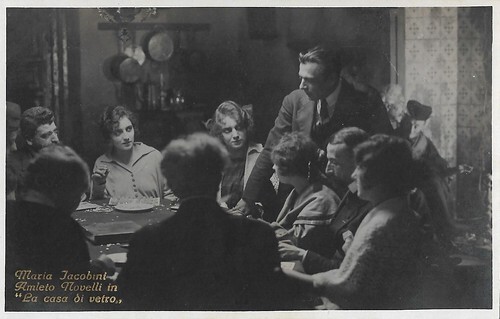
Italian postcard by G.B. Falci, Milano. Photo: Fert. Maria Jacobini and Amleto Novelli in La casa di vetro/The Glass House (Gennaro Righelli, 1920).
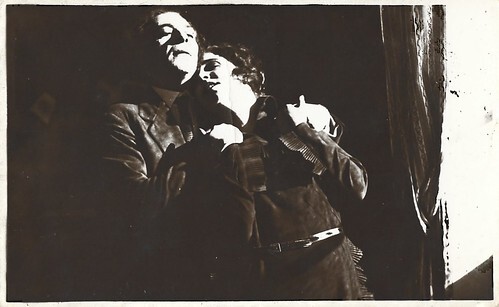
Vintage Italian postcard. FERT. Maria Jacobini and Amleto Novelli in La casa di vetro/ The Glass House (Gennaro Righelli, 1920). Caption: Sogno nella luna (Dreaming by Moonlight).
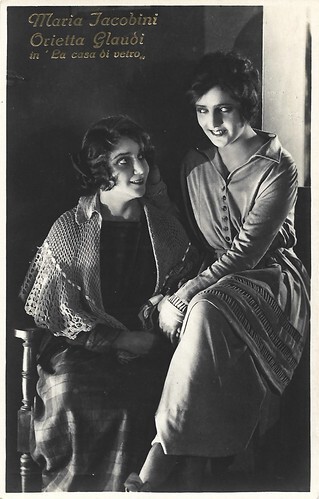
Italian postcard by G.B. Falci, Milano, 317. Photo: Maria Jacobini and Orietta Claudi in La casa di vetro/The Glass House (Gennaro Righelli, 1920).
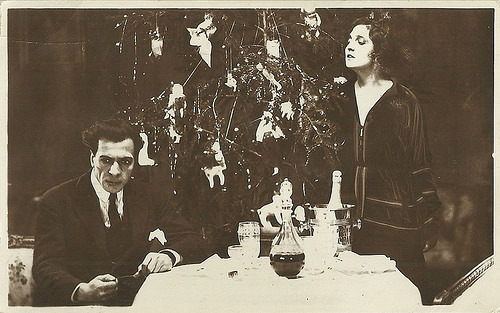
Italian postcard. Caption on the back: 'Triste Natale' (Sad Christmas). Photo: Fert. Publicity still for La casa di vetro/The Glass House (Gennaro Righelli, 1920), starring Maria Jacobini and Amleto Novelli .
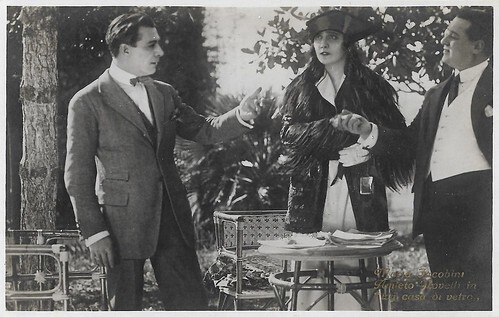
Italian postcard by G.B. Falci, Milano. Photo: Fert. Maria Jacobini , Amleto Novelli and Oreste Bilancia in La casa di vetro/The Glass House (Gennaro Righelli, 1920).
Breaking glass
Italian diva Maria Jacobini plays in La casa di vetro/The Glass House (Gennaro Righelli 1920) the mundane city girl Gaby Printemps. During a trip, accompanied by her good friend Max (Oreste Bilancia), Gaby is struck by the quiet life in a mountain village and decides to remain there. She meets Roberto Landi ( Amleto Novelli ), a simple and honest young man, and the two fall in love, creating endless suffering for Roberto's fiancee Grazia (Orietta Claudi) and his parents. They move to the city, but their different lifestyles soon become evident.
Moreover, jealous Max tries to split them. Roberto's father (Alfonso Cassini) decides to find his son and confronts him with the words that Gaby belongs to the species which one loves but not marries. In the end, Roberto admits his failure. On Christmas Eve he returns to the mountain village and reconciles with his old love Grazia and his parents. Gaby annihilates her memory by breaking a glass of champagne, as she says, "just like all glass houses do" (the title of the film).
In the Italian journal La vita cinematografica, Dioniso thought that 'The Glass House' was a misleading title, pretending transparency while several secrets are going on at Gaby's. And in the end, no home is destroyed as both lovers were not really planning to build one. The broken glass only refers to Gaby's broken heart. Instead, Dioniso praised the shots on location in the Italian countryside, at the foot of the Majella mountains.
Orietta Claudi had a relatively short career in Italian silent cinema of the early 1920s, mostly playing the young family girl opposite mundane divas such as Pina Menichelli, Italia Almirante Manzini and Maria Jacobini .
Scripted by Luciano Doria and future film director Nunzio Malasomma, La casa di vetro/The Glass House was produced by the Fert company of Turin and distributed by Pittaluga. Cinematography was by Tullio Chiarini. La casa di vetro had its Roman premiere on 21 February 1921.
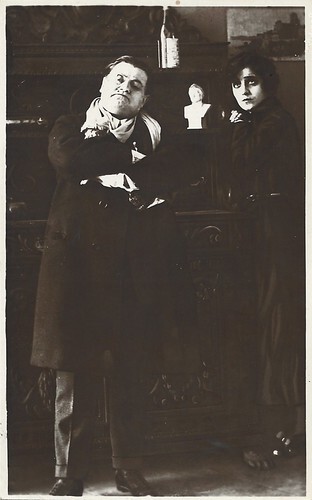
Italian postcard. Photo: Fert. Maria Jacobini and Oreste Bilancia in La casa di vetro/The Glass House (Gennaro Righelli, 1920). Caption: Tentazioni del passato (Temptations of the Past).
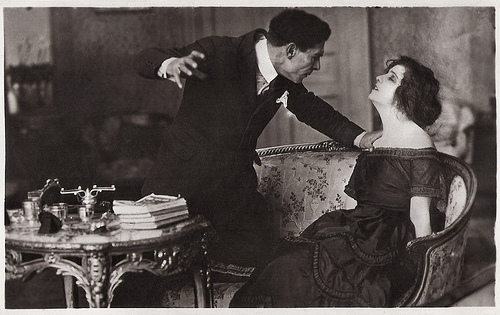
Italian postcard. Publicity still for La casa di vetro/The Glass House (Gennaro Righelli, 1920), starring Maria Jacobini and Amleto Novelli .
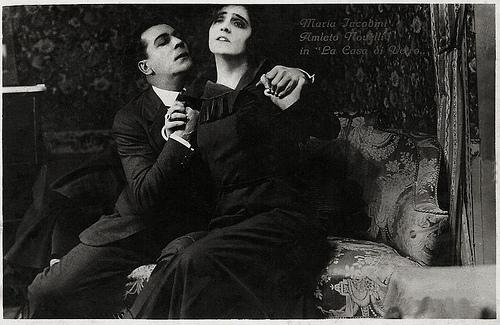
Italian postcard by G.B. Falci, Milano. Publicity still for La casa di vetro/The Glass House (Gennaro Righelli, 1920), starring Maria Jacobini and Amleto Novelli .
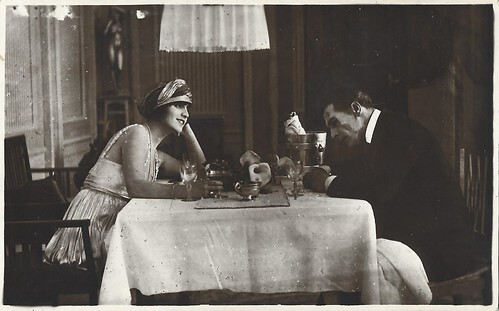
Italian postcard. Photo: FERT. Maria Jacobini and Amleto Novelli in La casa di vetro/The Glass House (Gennaro Righelli, 1920). Caption: Il primo ritorno alla vita d'un tempo (The First Return to the Former Life).
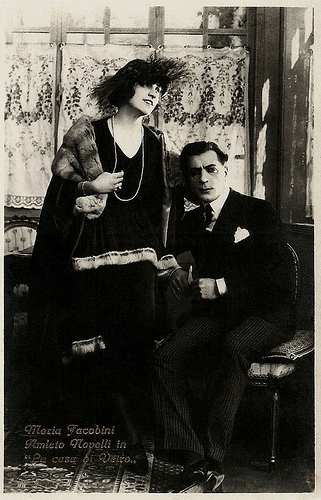
Italian postcard by G.B. Falci, Milano, no. 13. Publicity still for La casa di vetro/The Glass House (Gennaro Righelli, 1920), starring Maria Jacobini and Amleto Novelli .
Source: Vittorio Martinelli and Aldo Bernardini (Il Cinema Muto Italiano, Vol. 1920 - Italian), Wikipedia (Italian) and IMDb.

Italian postcard by G.B. Falci, Milano. Photo: publicity still for La casa di vetro/The Glass House (Gennaro Righelli, 1920), starring Maria Jacobini and Amleto Novelli .

Italian postcard by G.B. Falci, Milano. Photo: Fert. Maria Jacobini and Amleto Novelli in La casa di vetro/The Glass House (Gennaro Righelli, 1920).

Vintage Italian postcard. FERT. Maria Jacobini and Amleto Novelli in La casa di vetro/ The Glass House (Gennaro Righelli, 1920). Caption: Sogno nella luna (Dreaming by Moonlight).

Italian postcard by G.B. Falci, Milano, 317. Photo: Maria Jacobini and Orietta Claudi in La casa di vetro/The Glass House (Gennaro Righelli, 1920).

Italian postcard. Caption on the back: 'Triste Natale' (Sad Christmas). Photo: Fert. Publicity still for La casa di vetro/The Glass House (Gennaro Righelli, 1920), starring Maria Jacobini and Amleto Novelli .

Italian postcard by G.B. Falci, Milano. Photo: Fert. Maria Jacobini , Amleto Novelli and Oreste Bilancia in La casa di vetro/The Glass House (Gennaro Righelli, 1920).
Breaking glass
Italian diva Maria Jacobini plays in La casa di vetro/The Glass House (Gennaro Righelli 1920) the mundane city girl Gaby Printemps. During a trip, accompanied by her good friend Max (Oreste Bilancia), Gaby is struck by the quiet life in a mountain village and decides to remain there. She meets Roberto Landi ( Amleto Novelli ), a simple and honest young man, and the two fall in love, creating endless suffering for Roberto's fiancee Grazia (Orietta Claudi) and his parents. They move to the city, but their different lifestyles soon become evident.
Moreover, jealous Max tries to split them. Roberto's father (Alfonso Cassini) decides to find his son and confronts him with the words that Gaby belongs to the species which one loves but not marries. In the end, Roberto admits his failure. On Christmas Eve he returns to the mountain village and reconciles with his old love Grazia and his parents. Gaby annihilates her memory by breaking a glass of champagne, as she says, "just like all glass houses do" (the title of the film).
In the Italian journal La vita cinematografica, Dioniso thought that 'The Glass House' was a misleading title, pretending transparency while several secrets are going on at Gaby's. And in the end, no home is destroyed as both lovers were not really planning to build one. The broken glass only refers to Gaby's broken heart. Instead, Dioniso praised the shots on location in the Italian countryside, at the foot of the Majella mountains.
Orietta Claudi had a relatively short career in Italian silent cinema of the early 1920s, mostly playing the young family girl opposite mundane divas such as Pina Menichelli, Italia Almirante Manzini and Maria Jacobini .
Scripted by Luciano Doria and future film director Nunzio Malasomma, La casa di vetro/The Glass House was produced by the Fert company of Turin and distributed by Pittaluga. Cinematography was by Tullio Chiarini. La casa di vetro had its Roman premiere on 21 February 1921.

Italian postcard. Photo: Fert. Maria Jacobini and Oreste Bilancia in La casa di vetro/The Glass House (Gennaro Righelli, 1920). Caption: Tentazioni del passato (Temptations of the Past).

Italian postcard. Publicity still for La casa di vetro/The Glass House (Gennaro Righelli, 1920), starring Maria Jacobini and Amleto Novelli .

Italian postcard by G.B. Falci, Milano. Publicity still for La casa di vetro/The Glass House (Gennaro Righelli, 1920), starring Maria Jacobini and Amleto Novelli .

Italian postcard. Photo: FERT. Maria Jacobini and Amleto Novelli in La casa di vetro/The Glass House (Gennaro Righelli, 1920). Caption: Il primo ritorno alla vita d'un tempo (The First Return to the Former Life).

Italian postcard by G.B. Falci, Milano, no. 13. Publicity still for La casa di vetro/The Glass House (Gennaro Righelli, 1920), starring Maria Jacobini and Amleto Novelli .
Source: Vittorio Martinelli and Aldo Bernardini (Il Cinema Muto Italiano, Vol. 1920 - Italian), Wikipedia (Italian) and IMDb.
Published on September 28, 2024 22:00
September 27, 2024
Priscilla Lane
Pretty American actress and singer Priscilla Lane (1915-1995) was the youngest of the Lane sisters. Rosemary, Lola, Leota and Priscilla Lane worked in show business from an early age. Priscilla became known for films such as The Roaring Twenties (1939), Saboteur (1942) and Arsenic and Lace (1944). She was often cast as the pretty girlfriend, fiancée or daughter. Like her sisters, she stopped her career fairly quickly to devote herself fully to her role as a mother.
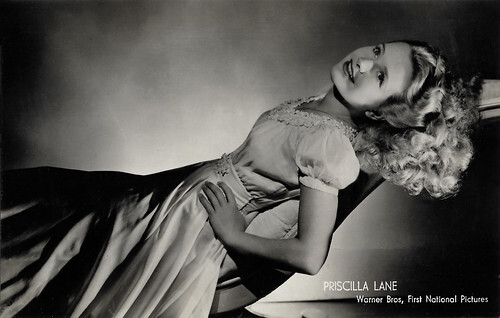
Dutch postcard, no. 641. Photo: Warner Bros / First National Pictures.
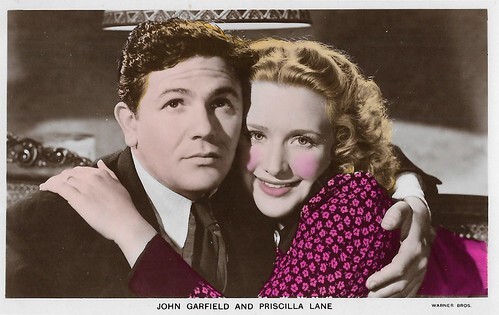
British postcard in the Film Partner series, no. PC 303. Photo: Warner Bros. John Garfield and Priscilla Lane in Four Daughters (Michael Curtiz, 1938).
The springboard she needed to propel her Hollywood career
Priscilla Lane was born Priscilla Mullican in 1915 in Indianola, a small college town south of Des Moines, Iowa. She was the youngest of five daughters of Lorenzo Mullican and his wife, Cora Bell Hicks. Dr. Mullican had a dental practice in Indianola. Shortly before she was born, her parents moved into a large house with twenty-two bedrooms, where she and her four sisters could spend their childhood learning music and singing.
In 1930, Priscilla, then 15, made her stage debut at Des Moines' Paramount Theatre as part of the entertainment accompanying the release of her sister Lola's Hollywood film Good News (Nick Grinde, 1930) starring Bessie Love . Priscilla studied at the Eagin School of Dramatic Arts in New York. She began touring with her sisters Leota, Rosemary and Lola in the Fred Waring and the Pennsylvanians Dance Band. They became a popular singing act.
In 1937, Rosemary and Priscilla signed a contract with Warner Brothers Studios. Their film debut was Varsity Show (William Keighley, 1937), a musical starring Dick Powell . Priscilla had the hard task of portraying a singer with the Fred Waring Band. Her next film was the romantic comedy Men Are Such Fools (Busby Berkeley, 1938), in which she starred with Wayne Morris and Humphrey Bogart . Unlike her sister, Rosemary who played the spirited star in Hollywood films, Priscilla was confined to the role of the pretty girlfriend, fiancée or daughter.
In 1938, Bette Davis refused the lead role in Four Daughters (Michael Curtiz, 1938), an adaptation of Fannie Hurst's novel 'Sister Act'. Priscilla's sister, Lola Lane, suggested to Jack L. Warner that she and her three other sisters star in the tearjerker about the Lemp family. Priscilla and Rosemary Lane were signed on, but the oldest sister Leota Lane, who was flown in from New York to test for the part, was deemed unsuitable by the studio. Actress Gale Page replaced her. Four Daughters (Michael Curtiz, 1938) also with Claude Rains and John Garfield , was one of the great successes of Priscilla's career. It was followed by two sequels: Four Wives (Michael Curtiz, 1939) and Four Mothers (William Keighley, 1941).
The same cast also appeared in the film Daughters Courageous (Michael Curtiz, 1939), which had no connection with the Lemp family trilogy. With Leota, the sisters appeared in a 'Lux Radio Theatre' adaptation of 'Four Daughters' in 1939. In 1939, Priscilla impulsively married the assistant director and screenwriter Oren Haglund in Yuma, Arizona. However, she left her husband the very next day and the marriage was annulled in May. That same year, she was up for the role of Melanie Wilkes in Gone with the Wind (Victor Fleming, George Cukor, Sam Wood, 1939), but she didn't get the part. In most of her films till then, all Priscilla had to do was look attractive and give a good supporting performance. However, she played James Cagney 's girlfriend in the crime film The Roaring Twenties (Raoul Walsh, 1939) with Humphrey Bogart . This was the springboard she needed to propel her Hollywood career.
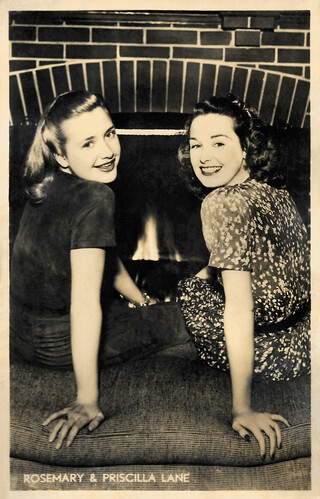
Dutch postcard by J.S.A. Photo: Warner Bros / M.P.E. Rosemary Lane and Priscilla Lane.
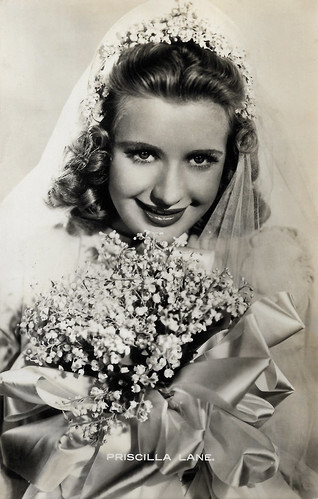
Dutch postcard by Sparo.
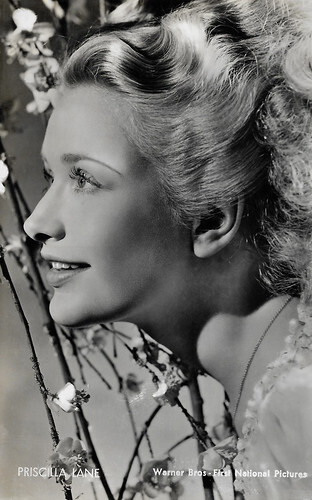
Dutch postcard by J.S.A., no. 840. Photo: Warner Bros / First National Pictures.
One of her career highlights
Over the next few years, Priscilla Lane was successful as a classic leading lady. At Warner Bros., she appeared in a lighthearted comedy Million Dollar Baby (Curtis Bernhardt, 1941), opposite Jeffrey Lynn and Ronald Reagan , and as a night club singer in the musical Blues in the Night (Anatole Litvak 1941).
In the comedy classic Arsenic and Old Lace (Frank Capra, 1944), she appeared as Cary Grant's newlywed wife. The film was only released two years later after it was shot because, as stipulated in the contract, it could not be shown while the play was still running on Broadway. It was Priscilla's last Warner film. Her contract was terminated by mutual agreement after five years with the studio. She freelanced next.
When Barbara Stanwyck was not available for the female lead in the Hitchcock thriller Saboteur (Alfred Hitchcock, 1942) with Robert Cummings, Priscilla was given the role. It became one of her career highlights. She co-starred with George Brent in Silver Queen (Lloyd Bacon, 1942) for producer Harry Sherman. Lane played the owner of a gambling house in 1870s San Francisco.
In 1942, she married Colonel Joseph A. Howard of the U.S. Air Force. She acted in a Jack Benny comedy, The Meanest Man in the World (Sidney Lanfield, Ernst Lubitsch, 1943) and then retired from films. She accompanied her husband around the world to sing for the soldiers at his posts. After the war, she accepted the leading role in Fun on a Weekend (1947) for producer-director Andrew Stone, co-starring Eddie Bracken. The following year, she starred in the Film Noir Bodyguard (Richard Fleischer, 1948), with Lawrence Tierney. It was her last screen appearance.
She and her husband eventually settled in New England and had four children: Joseph Lawrence (1945), Hannah (1950), Judith (1953) and James (1955). Priscilla returned to show business briefly in 1958 with The Priscilla Lane Show on a local television station broadcasting from Boston. She chatted and interviewed celebrities visiting the area. She enjoyed the television experience, but family demands proved too much, and she gave up after a year. 19 years after her husband died in 1976, Priscilla Lane passed away from lung cancer and chronic heart failure in 1995 at the age of 79. She was buried next to her husband at Arlington National Cemetery.
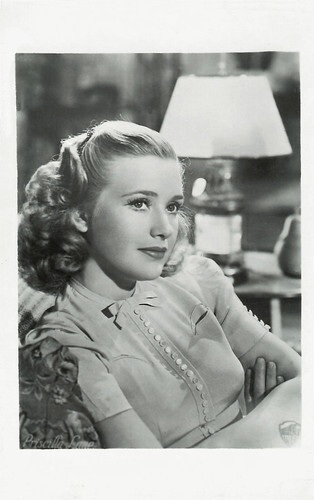
Vintage postcard. Photo: Warner Bros.
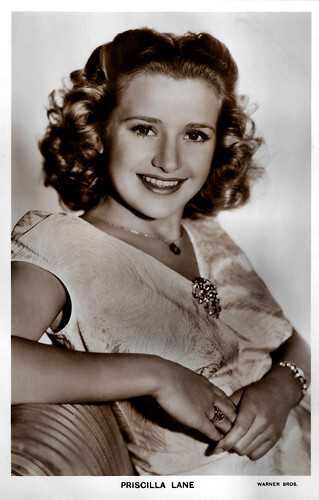
British postcard in the Picturegoer Series, London, no. W 17. Photo: Warner Bros.
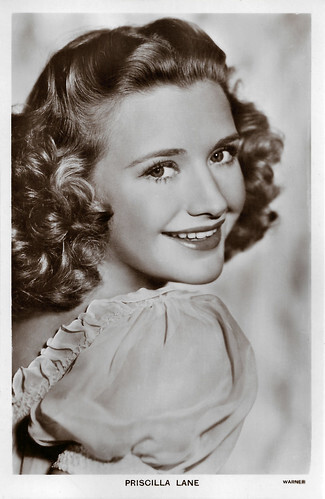
British postcard in the Picturegoer Series, London, no. 1202a. Photo: Warner Bros.
Sources: (IMDb), Wikipedia (German, French and English) and .

Dutch postcard, no. 641. Photo: Warner Bros / First National Pictures.

British postcard in the Film Partner series, no. PC 303. Photo: Warner Bros. John Garfield and Priscilla Lane in Four Daughters (Michael Curtiz, 1938).
The springboard she needed to propel her Hollywood career
Priscilla Lane was born Priscilla Mullican in 1915 in Indianola, a small college town south of Des Moines, Iowa. She was the youngest of five daughters of Lorenzo Mullican and his wife, Cora Bell Hicks. Dr. Mullican had a dental practice in Indianola. Shortly before she was born, her parents moved into a large house with twenty-two bedrooms, where she and her four sisters could spend their childhood learning music and singing.
In 1930, Priscilla, then 15, made her stage debut at Des Moines' Paramount Theatre as part of the entertainment accompanying the release of her sister Lola's Hollywood film Good News (Nick Grinde, 1930) starring Bessie Love . Priscilla studied at the Eagin School of Dramatic Arts in New York. She began touring with her sisters Leota, Rosemary and Lola in the Fred Waring and the Pennsylvanians Dance Band. They became a popular singing act.
In 1937, Rosemary and Priscilla signed a contract with Warner Brothers Studios. Their film debut was Varsity Show (William Keighley, 1937), a musical starring Dick Powell . Priscilla had the hard task of portraying a singer with the Fred Waring Band. Her next film was the romantic comedy Men Are Such Fools (Busby Berkeley, 1938), in which she starred with Wayne Morris and Humphrey Bogart . Unlike her sister, Rosemary who played the spirited star in Hollywood films, Priscilla was confined to the role of the pretty girlfriend, fiancée or daughter.
In 1938, Bette Davis refused the lead role in Four Daughters (Michael Curtiz, 1938), an adaptation of Fannie Hurst's novel 'Sister Act'. Priscilla's sister, Lola Lane, suggested to Jack L. Warner that she and her three other sisters star in the tearjerker about the Lemp family. Priscilla and Rosemary Lane were signed on, but the oldest sister Leota Lane, who was flown in from New York to test for the part, was deemed unsuitable by the studio. Actress Gale Page replaced her. Four Daughters (Michael Curtiz, 1938) also with Claude Rains and John Garfield , was one of the great successes of Priscilla's career. It was followed by two sequels: Four Wives (Michael Curtiz, 1939) and Four Mothers (William Keighley, 1941).
The same cast also appeared in the film Daughters Courageous (Michael Curtiz, 1939), which had no connection with the Lemp family trilogy. With Leota, the sisters appeared in a 'Lux Radio Theatre' adaptation of 'Four Daughters' in 1939. In 1939, Priscilla impulsively married the assistant director and screenwriter Oren Haglund in Yuma, Arizona. However, she left her husband the very next day and the marriage was annulled in May. That same year, she was up for the role of Melanie Wilkes in Gone with the Wind (Victor Fleming, George Cukor, Sam Wood, 1939), but she didn't get the part. In most of her films till then, all Priscilla had to do was look attractive and give a good supporting performance. However, she played James Cagney 's girlfriend in the crime film The Roaring Twenties (Raoul Walsh, 1939) with Humphrey Bogart . This was the springboard she needed to propel her Hollywood career.

Dutch postcard by J.S.A. Photo: Warner Bros / M.P.E. Rosemary Lane and Priscilla Lane.

Dutch postcard by Sparo.

Dutch postcard by J.S.A., no. 840. Photo: Warner Bros / First National Pictures.
One of her career highlights
Over the next few years, Priscilla Lane was successful as a classic leading lady. At Warner Bros., she appeared in a lighthearted comedy Million Dollar Baby (Curtis Bernhardt, 1941), opposite Jeffrey Lynn and Ronald Reagan , and as a night club singer in the musical Blues in the Night (Anatole Litvak 1941).
In the comedy classic Arsenic and Old Lace (Frank Capra, 1944), she appeared as Cary Grant's newlywed wife. The film was only released two years later after it was shot because, as stipulated in the contract, it could not be shown while the play was still running on Broadway. It was Priscilla's last Warner film. Her contract was terminated by mutual agreement after five years with the studio. She freelanced next.
When Barbara Stanwyck was not available for the female lead in the Hitchcock thriller Saboteur (Alfred Hitchcock, 1942) with Robert Cummings, Priscilla was given the role. It became one of her career highlights. She co-starred with George Brent in Silver Queen (Lloyd Bacon, 1942) for producer Harry Sherman. Lane played the owner of a gambling house in 1870s San Francisco.
In 1942, she married Colonel Joseph A. Howard of the U.S. Air Force. She acted in a Jack Benny comedy, The Meanest Man in the World (Sidney Lanfield, Ernst Lubitsch, 1943) and then retired from films. She accompanied her husband around the world to sing for the soldiers at his posts. After the war, she accepted the leading role in Fun on a Weekend (1947) for producer-director Andrew Stone, co-starring Eddie Bracken. The following year, she starred in the Film Noir Bodyguard (Richard Fleischer, 1948), with Lawrence Tierney. It was her last screen appearance.
She and her husband eventually settled in New England and had four children: Joseph Lawrence (1945), Hannah (1950), Judith (1953) and James (1955). Priscilla returned to show business briefly in 1958 with The Priscilla Lane Show on a local television station broadcasting from Boston. She chatted and interviewed celebrities visiting the area. She enjoyed the television experience, but family demands proved too much, and she gave up after a year. 19 years after her husband died in 1976, Priscilla Lane passed away from lung cancer and chronic heart failure in 1995 at the age of 79. She was buried next to her husband at Arlington National Cemetery.

Vintage postcard. Photo: Warner Bros.

British postcard in the Picturegoer Series, London, no. W 17. Photo: Warner Bros.

British postcard in the Picturegoer Series, London, no. 1202a. Photo: Warner Bros.
Sources: (IMDb), Wikipedia (German, French and English) and .
Published on September 27, 2024 22:00
September 26, 2024
Leila Hyams
Charming American model, vaudeville and film actress Leila Hyams (1905-1977) was one of Hollywood's top leading ladies of the early talkie pre-code years. She had spark, personality, charisma, and a touch of down-to-earthness and naturalness that won over movie fans. They could relate to her. She is best known for her roles in the classic horror features Freaks (1932) and Island of Lost Souls (1932). Her career lasted little more than a decade.
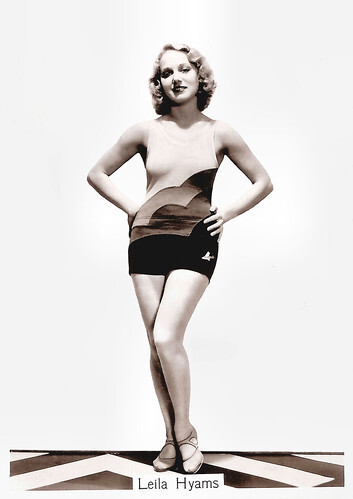
Cigarette card by Godfrey Phillips Ltd. and Associated Companies in the Beauties of To-day series, Second Series, no. 19.
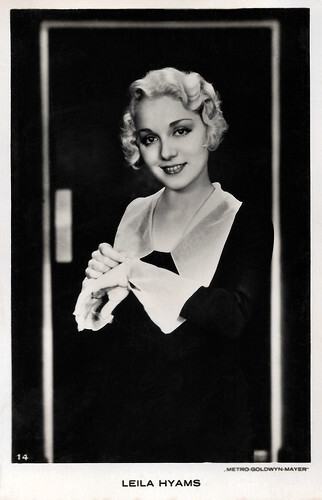
Dutch postcard, no. 14. Photo: Metro-Goldwyn-Mayer.
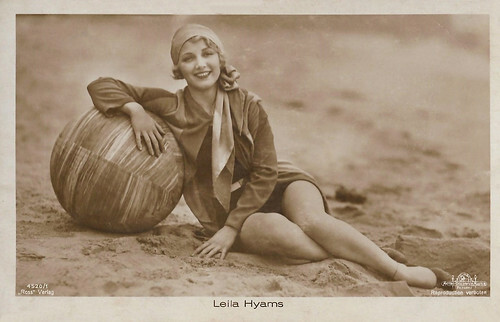
German postcard by Ross Verlag, no. 4520/1, 1929-1930. Photo: Metro-Goldwyn-Mayer.
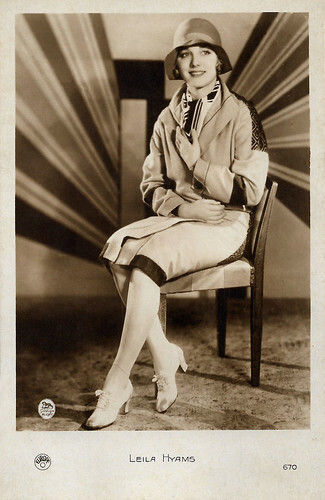
French postcard by Europe, no. 670. Photo: Metro-Goldwyn-Mayer.
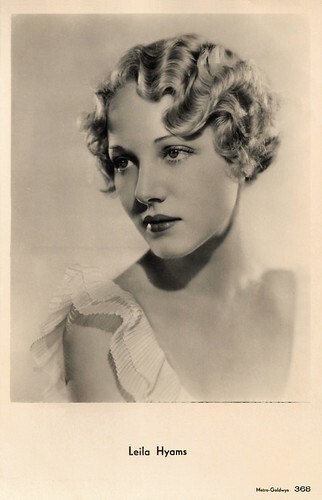
Dutch postcard by JosPe, Arnhem, no. 368. Photo: Metro-Goldwyn.
Her blonde hair, delicate features and innocent sex appeal
Leila Hyams was born in 1905 in New York City, USA. Her parents were the vaudeville comedy performers John Hyams and Leila McIntyre. Both her parents had careers in films and can be seen together in The Housekeeper's Daughter (1939).
As soon as she could walk, Leila appeared onstage with her parents, and as a teenager, she worked as a model and became well-known after appearing in a successful series of newspaper advertisements. She was the first person to model for Listerine mouthwash.
This success led her to Hollywood, and she made her first film appearance in Sandra (Arthur H. Sawyer, 1924) with Barbara La Marr . Her blonde hair, delicate features and innocent sex appeal led to a variety of supporting roles, where she was required to do very little but smile and look pretty. She proved herself capable of handling these parts, and she came to be taken seriously as an actress.
By 1928 she was appearing in starring roles and achieved success in MGM's first talking film, Alias Jimmy Valentine (Jack Conway, 1928) opposite William Haines and Lionel Barrymore . It was followed by Spite Marriage (Edward Sedgwick, 1929) starring Buster Keaton .
She was once described as 'The Golden Girl' by an artist because of her perfect pink skin and blonde hair colouring and, according to a 1928 Photoplay Magazine article, she carried a small satin case suspended from her garter that contained an extra pair of stockings, in case the ones she was wearing were damaged. Leila appeared opposite Conrad Nagel in the popular murder mystery The Thirteenth Chair (Tod Browning, 1929), a role that offered her the chance to display her dramatic abilities as a murder suspect.
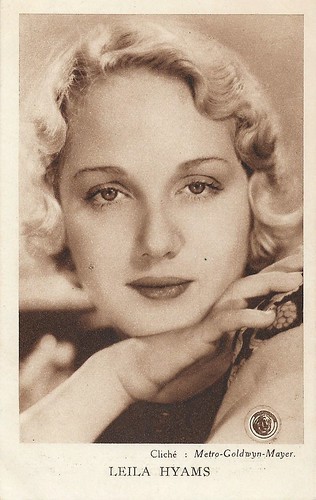
Belgian postcard by S.A. Cacao et Chocolat Kivou, Vilvo[o]rde, Belgium.
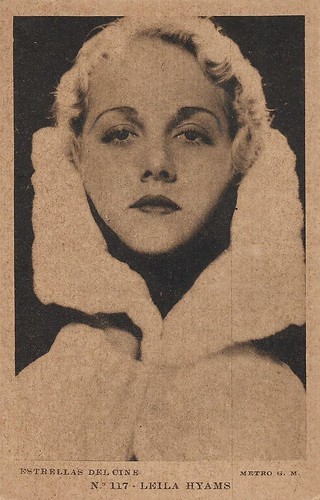
Spanish postcard in the Estrellas del cine series by Editorial Grafica, Barcelona, no. 117. Photo: Metro-Goldwyn-Mayer.
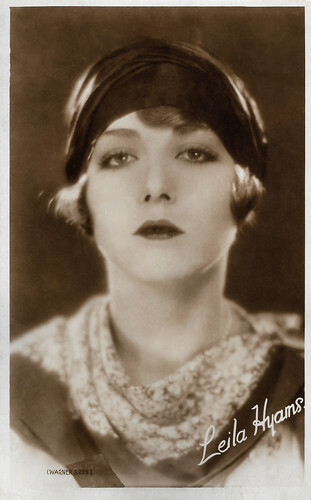
British postcard in the Second Cinema Stars series by Sarony Cigarettes, no. 70. Photo: Warner Bros.
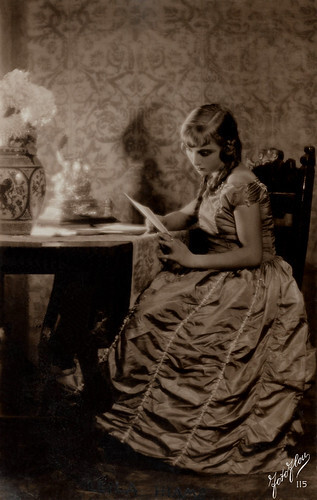
Italian postcard by FotoFlou, no. 115.
A versatile, excellent actress
The quality of Leila Hyams's parts continued to improve, which included a role as Robert Montgomery 's sister in the prison drama The Big House (George W. Hill, 1930), with Chester Morris and Wallace Beery , for which she again received positive reviews.
She is best remembered for two early 1930s horror movies. In Tod Browning's controversial Freaks (1932), she played the wise-cracking, kind-hearted circus performer Venus and gave a compassionate performance. Next, she was the heroine in Island of Lost Souls (Erle C. Kenton, 1932) with Charles Laughton and Bela Lugosi .
She also appeared in the sexy and funny Jean Harlow film Red-Headed Woman (Jack Conway, 1932), and the musical comedy The Big Broadcast (Frank Tuttle, 1932) with Bing Crosby in his first starring role, George Burns, and Gracie Allen. Another memorable performance was as the good-natured saloon girl who teaches Roland Young to play the drums in Ruggles of Red Gap (Leo McCarey, 1935). Her last film was Yellow Dust (Wallace Fox, 1936) with Richard Dix .
After ten years and 50 films, Leila decided to concentrate on her personal life and retired from acting in 1936. Alicia T at IMDb : "A versatile, excellent actress she was, able to conform to any role and maintain that special heartfelt sincerity she always displayed in her role. Her image on screen was beautiful but not conceited, not high and mighty, tough but sweet and she had sex appeal but always came across as a lady who managed to keep her innocence. Those were the qualities that carried her to fame and set her apart from the other leading ladies of early Hollywood."
After her retirement, Hyams remained a part of the Hollywood community. Reportedly, she was very shrewd about protecting her assets, putting a picture of herself on all her checks so they would be impossible to cash if they were stolen. Hyams returned once to the screen as a Red Cross worker in the short First Aid (Will Jason, 1943). She was married to agent Phil Berg for 50 years, from 1927 until her death. Leila Hyams passed away from natural causes in 1977, in Bel-Air, CA. She was 72.
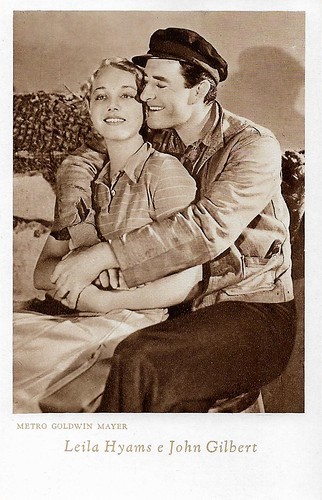
Italian postcard by Cinema-Illustrazione, series II, no. 15. Photo: Metro-Goldwyn-Mayer. John Gilbert and Leila Hyams in Way of a Sailor (Sam Wood, 1930).
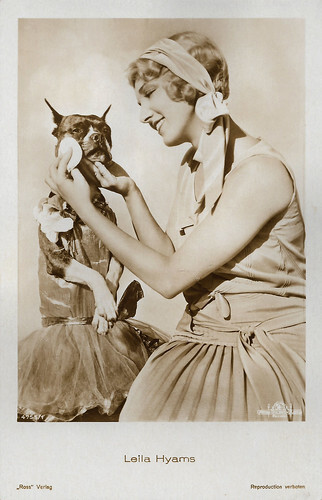
German postcard by Ross Verlag, no. 4755/1, 1929-1930. Photo: Metro-Goldwyn-Mayer.
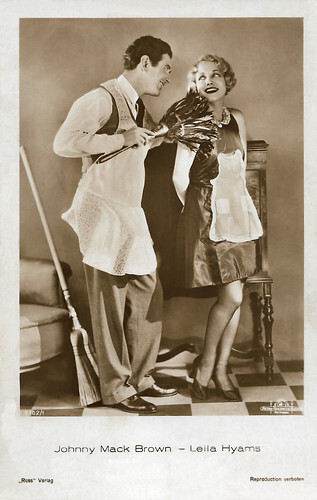
German postcard by Ross Verlag, no. 5102/1, 1930-1931. Photo: Metro-Goldwyn-Mayer. Johnny Mack Brown and Leila Hyams starred together in such films as Hurricane (Ralph Ince, 1929) and Saturday's Millions (Edward Sedgwick, 1933).
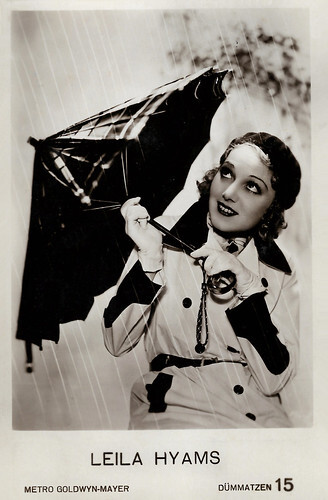
German postcard by Dümmatzen, no. 15. Photo: Metro-Goldwyn-Mayer.
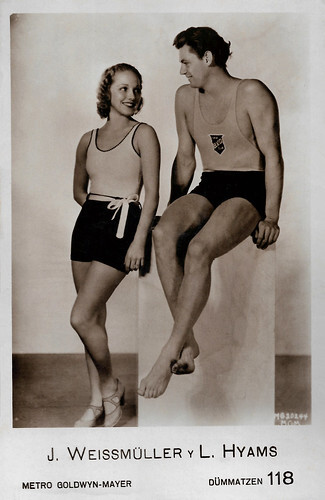
Spanish postcard by Dümmatzen, no. 118. Photo: Metro Goldwyn Mayer. Leila Hyams and Johnny Weissmuller .
Sources: (IMDb), (IMDb), Wikipedia and .

Cigarette card by Godfrey Phillips Ltd. and Associated Companies in the Beauties of To-day series, Second Series, no. 19.

Dutch postcard, no. 14. Photo: Metro-Goldwyn-Mayer.

German postcard by Ross Verlag, no. 4520/1, 1929-1930. Photo: Metro-Goldwyn-Mayer.

French postcard by Europe, no. 670. Photo: Metro-Goldwyn-Mayer.

Dutch postcard by JosPe, Arnhem, no. 368. Photo: Metro-Goldwyn.
Her blonde hair, delicate features and innocent sex appeal
Leila Hyams was born in 1905 in New York City, USA. Her parents were the vaudeville comedy performers John Hyams and Leila McIntyre. Both her parents had careers in films and can be seen together in The Housekeeper's Daughter (1939).
As soon as she could walk, Leila appeared onstage with her parents, and as a teenager, she worked as a model and became well-known after appearing in a successful series of newspaper advertisements. She was the first person to model for Listerine mouthwash.
This success led her to Hollywood, and she made her first film appearance in Sandra (Arthur H. Sawyer, 1924) with Barbara La Marr . Her blonde hair, delicate features and innocent sex appeal led to a variety of supporting roles, where she was required to do very little but smile and look pretty. She proved herself capable of handling these parts, and she came to be taken seriously as an actress.
By 1928 she was appearing in starring roles and achieved success in MGM's first talking film, Alias Jimmy Valentine (Jack Conway, 1928) opposite William Haines and Lionel Barrymore . It was followed by Spite Marriage (Edward Sedgwick, 1929) starring Buster Keaton .
She was once described as 'The Golden Girl' by an artist because of her perfect pink skin and blonde hair colouring and, according to a 1928 Photoplay Magazine article, she carried a small satin case suspended from her garter that contained an extra pair of stockings, in case the ones she was wearing were damaged. Leila appeared opposite Conrad Nagel in the popular murder mystery The Thirteenth Chair (Tod Browning, 1929), a role that offered her the chance to display her dramatic abilities as a murder suspect.

Belgian postcard by S.A. Cacao et Chocolat Kivou, Vilvo[o]rde, Belgium.

Spanish postcard in the Estrellas del cine series by Editorial Grafica, Barcelona, no. 117. Photo: Metro-Goldwyn-Mayer.

British postcard in the Second Cinema Stars series by Sarony Cigarettes, no. 70. Photo: Warner Bros.

Italian postcard by FotoFlou, no. 115.
A versatile, excellent actress
The quality of Leila Hyams's parts continued to improve, which included a role as Robert Montgomery 's sister in the prison drama The Big House (George W. Hill, 1930), with Chester Morris and Wallace Beery , for which she again received positive reviews.
She is best remembered for two early 1930s horror movies. In Tod Browning's controversial Freaks (1932), she played the wise-cracking, kind-hearted circus performer Venus and gave a compassionate performance. Next, she was the heroine in Island of Lost Souls (Erle C. Kenton, 1932) with Charles Laughton and Bela Lugosi .
She also appeared in the sexy and funny Jean Harlow film Red-Headed Woman (Jack Conway, 1932), and the musical comedy The Big Broadcast (Frank Tuttle, 1932) with Bing Crosby in his first starring role, George Burns, and Gracie Allen. Another memorable performance was as the good-natured saloon girl who teaches Roland Young to play the drums in Ruggles of Red Gap (Leo McCarey, 1935). Her last film was Yellow Dust (Wallace Fox, 1936) with Richard Dix .
After ten years and 50 films, Leila decided to concentrate on her personal life and retired from acting in 1936. Alicia T at IMDb : "A versatile, excellent actress she was, able to conform to any role and maintain that special heartfelt sincerity she always displayed in her role. Her image on screen was beautiful but not conceited, not high and mighty, tough but sweet and she had sex appeal but always came across as a lady who managed to keep her innocence. Those were the qualities that carried her to fame and set her apart from the other leading ladies of early Hollywood."
After her retirement, Hyams remained a part of the Hollywood community. Reportedly, she was very shrewd about protecting her assets, putting a picture of herself on all her checks so they would be impossible to cash if they were stolen. Hyams returned once to the screen as a Red Cross worker in the short First Aid (Will Jason, 1943). She was married to agent Phil Berg for 50 years, from 1927 until her death. Leila Hyams passed away from natural causes in 1977, in Bel-Air, CA. She was 72.

Italian postcard by Cinema-Illustrazione, series II, no. 15. Photo: Metro-Goldwyn-Mayer. John Gilbert and Leila Hyams in Way of a Sailor (Sam Wood, 1930).

German postcard by Ross Verlag, no. 4755/1, 1929-1930. Photo: Metro-Goldwyn-Mayer.

German postcard by Ross Verlag, no. 5102/1, 1930-1931. Photo: Metro-Goldwyn-Mayer. Johnny Mack Brown and Leila Hyams starred together in such films as Hurricane (Ralph Ince, 1929) and Saturday's Millions (Edward Sedgwick, 1933).

German postcard by Dümmatzen, no. 15. Photo: Metro-Goldwyn-Mayer.

Spanish postcard by Dümmatzen, no. 118. Photo: Metro Goldwyn Mayer. Leila Hyams and Johnny Weissmuller .
Sources: (IMDb), (IMDb), Wikipedia and .
Published on September 26, 2024 22:00
September 25, 2024
Alexander den Store (1917)
Mauritz Stiller directed the silent Swedish comedy of manners, morals and aspiration, Alexander den Store/Alexander the Great (1917) with Hauk Aabel and Stina Stockenstam. Stiller himself wrote the script, based on the Gustav Esmann play of the same name. Alexander the Great is a provincial hotel cook, in whose restaurant not only the dishes can be spicy.
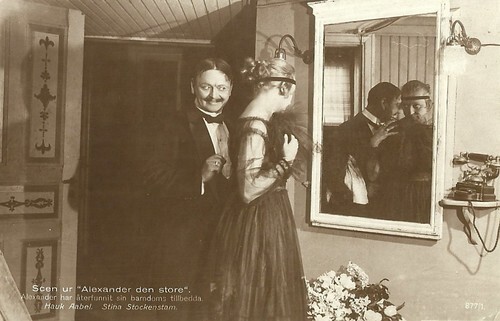
Swedish postcard by Nordisk Konst, Stockholm, no. 877/1. Photo: Svenska Biografteatern AB. Hauk Aabel and Stina Stockenstam in Alexander den Store/Alexander the Great (Mauritz Stiller, 1917). Caption: Alexander has rediscovered his beloved from his youth.
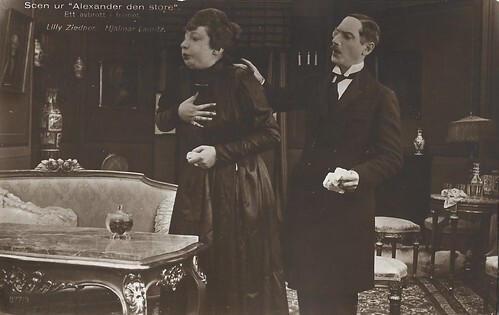
Swedish postcard by Förlag Nordisk Konst, Stockholm, no. 877/3. Photo: Svenska Biografteatern AB. Lilly Ziedner and Hjalmar Lauritz in Alexander den Store/Alexander the Great (Mauritz Stiller, 1917). Caption: A break in the courtship. Depicted are Lt. Squire Axel Axel Bryde (Hjalmar Lauritz), nephew of the Chamberlain Bryde, and Bera Mönther, daughter of State Council member Mönther.
The plot
Alexander Nyberg (Hauk Aabel) is the maitre d' and ruler of an elegant and fashionable restaurant, where beautiful dancers perform and gentlemen and ladies like to drink in private rooms. Among the vistors are the sisters Signe (Stina Stockenstam) and Filippa (Anna-Lisa Lindzén). Signe performs on stage and has an old, faithful admirer in Alexander Nyberg. Filippa sets out to catch the rich businessman Moses Isacsen (August Miehe), with whom she is happy to drink in private.
However, zealous people led by Thea Mönther (Gucken Cederborg), a government minister' wife, and Teodor Lampe (Harald Madsen), a theology graduate, have formed a 'mrality association'to combat the growing immorality. Nberg's restaurant is singled out in particular. Now begins a wild merry-go-round, where both the cheerful practitioners of “immorality” and its strict, puritanical opponents get involved in one comical and easily misunderstood situation after another in various rooms at Alexander Nyberg's restaurant.
But the superb maitre d' manages to sort it all out in the end. Meanwhile, Thea Mönther is doing everything she can to marry off her daughter Bera (Lili Ziedner), who certainly cannot be accused of any excessive beauty. The designated victim is the deeply indebted chamberlain's nephew, squire Axel Bryde (Hjalmar Lauritz), who is finally forced to accept Bera. The engagement is announced at a grotesque soiree at the Society of Morals.
At the same time, it is decided to open a 'family hotel' as a counterweight to the evils of the time. The strongest thing that can be served there is lingonberry soda. Alexander Nyberg is appointed to manage the new hotel and supervise its guests. Professor Lampe also makes daily inspections of the kitchen and dining room, where he usually gets into trouble.
Bera and her fiancé look at a sketch of their future bedroom, and Filippa surprises Isacsen with an engagement ring. Meanwhile, Nyberg is fired as manager of the 'dry' family hotel. But then an old friend of Nyberg's shows up, waving thick bundles of banknotes and persuading him to open a brand new, Grand Hotel Nyberg. Said and done. It opens with the grand society wedding between Bera and her chamberlain, and the evening ends with Alexander Nyberg, now bigger and more powerful than ever, proposing to Signe and getting her yes.
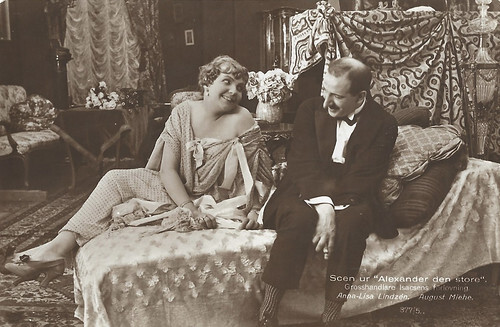
Swedish postcard by Förlag Nordisk Konst, Stockholm, no. 877/5. Photo: Svenska Biografteatern AB. August Miehe and Anna-Lisa Lindzén in Alexander den Store/Alexander the Great (Mauritz Stiller, 1917). Caption: Wholesaler Isacsen's engagement.
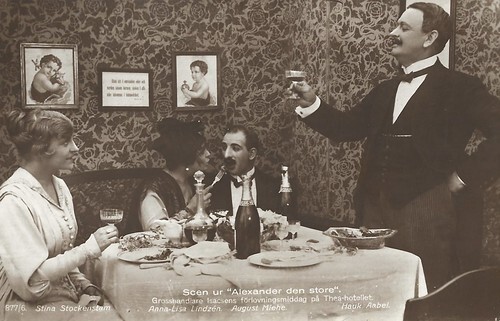
Swedish postcard by Förlag Nordisk Konst, Stockholm, no. 877/6. Photo: Svenska Biografteatern AB. Hauk Aabel, Stina Stockenstam, August Miehe, and Anna-Lisa Lindzén in Alexander den Store/Alexander the Great (Mauritz Stiller, 1917). Caption: Wholesaler Isacsen's engagement afternoon at Hotel Thea.
The cast
Hauk Erlendssøn Aabel (1869-1961) was a popular Norwegian comedian and actor in Norwegian and Swedish film. After Alexander den Store and one one Norwegian silent film, Troll-Elgen (Walter Fürst, 1927), he mainly acted in 1930s Norwegian sound cinema. He played the lead in the comedy Jeppe på bjerget (Per Aabel, Harry Ivarson, 1933).
Stina Stockenstam (1884-1919) acted in only three Swedish silent films in 1916-1917, including Alexander den Store. She acted on stage e.g. at the Old Theatre in Gothenburg. Stockenstam already died at the age of 34.
Anna Elisabet 'Anna-Lisa' Lindzén (1888-1949) was a Swedish operetta singer and actress. In addition to Alexander den Store, she only played in one other Swedish silent film, Den förgyllda lergöken (Bror Berger, 1924).
August Miehe (1889-1936) was a Danish actor.
Hjalmar Lauritz (1881-1921) was a Swedish stage actor. Squire Axel Axel Bryde in Alexander den Store was his only film role. Lauritz started his theatre career in 1899 at the Anna Lundberg-Axel Collin tour. From 1900 to 1903, he attended the Dramatic Theater's student school and in 1903-1904, he performed at the Swedish Theatre in Helsinki. In 1904-1905 he was engaged by Hjalmar Selander, in 1905-1907 by Emil Strömberg, in 1907-1909 by Axel Hultman, and then by Allan Ryding until his early death, with the exception of an engagement at Skådebanan in 1911-1912. Lauritz had a wide range as an actor. He could play both character and farce roles. Among his most notable roles are Richard III in Shakespeare's play, Armand in 'The Lady of the Camellias', Edgar and Kurt in 'The Dance of Death', Professor Higgins in 'Pygmalion', and Karl-Henrik in Wilhelm Meyer-Förster's 'Old Heidelberg'.
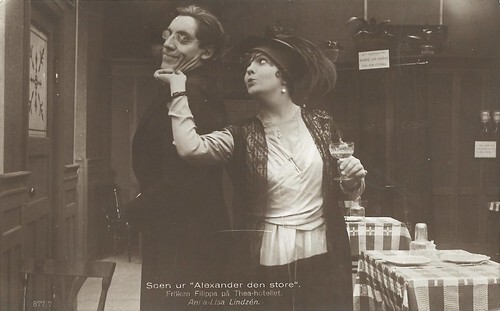
Swedish postcard by Förlag Nordisk Konst, Stockholm, no. 877/7. Photo: Svenska Biografteatern AB. Anna-Lisa Lindzén in Alexander den Store/Alexander the Great (Mauritz Stiller, 1917). Caption: Ms. Filippa at the Hotel Thea.
Sources: Svensk Filmdatabas, Wikipedia (Swedish) and IMDb.

Swedish postcard by Nordisk Konst, Stockholm, no. 877/1. Photo: Svenska Biografteatern AB. Hauk Aabel and Stina Stockenstam in Alexander den Store/Alexander the Great (Mauritz Stiller, 1917). Caption: Alexander has rediscovered his beloved from his youth.

Swedish postcard by Förlag Nordisk Konst, Stockholm, no. 877/3. Photo: Svenska Biografteatern AB. Lilly Ziedner and Hjalmar Lauritz in Alexander den Store/Alexander the Great (Mauritz Stiller, 1917). Caption: A break in the courtship. Depicted are Lt. Squire Axel Axel Bryde (Hjalmar Lauritz), nephew of the Chamberlain Bryde, and Bera Mönther, daughter of State Council member Mönther.
The plot
Alexander Nyberg (Hauk Aabel) is the maitre d' and ruler of an elegant and fashionable restaurant, where beautiful dancers perform and gentlemen and ladies like to drink in private rooms. Among the vistors are the sisters Signe (Stina Stockenstam) and Filippa (Anna-Lisa Lindzén). Signe performs on stage and has an old, faithful admirer in Alexander Nyberg. Filippa sets out to catch the rich businessman Moses Isacsen (August Miehe), with whom she is happy to drink in private.
However, zealous people led by Thea Mönther (Gucken Cederborg), a government minister' wife, and Teodor Lampe (Harald Madsen), a theology graduate, have formed a 'mrality association'to combat the growing immorality. Nberg's restaurant is singled out in particular. Now begins a wild merry-go-round, where both the cheerful practitioners of “immorality” and its strict, puritanical opponents get involved in one comical and easily misunderstood situation after another in various rooms at Alexander Nyberg's restaurant.
But the superb maitre d' manages to sort it all out in the end. Meanwhile, Thea Mönther is doing everything she can to marry off her daughter Bera (Lili Ziedner), who certainly cannot be accused of any excessive beauty. The designated victim is the deeply indebted chamberlain's nephew, squire Axel Bryde (Hjalmar Lauritz), who is finally forced to accept Bera. The engagement is announced at a grotesque soiree at the Society of Morals.
At the same time, it is decided to open a 'family hotel' as a counterweight to the evils of the time. The strongest thing that can be served there is lingonberry soda. Alexander Nyberg is appointed to manage the new hotel and supervise its guests. Professor Lampe also makes daily inspections of the kitchen and dining room, where he usually gets into trouble.
Bera and her fiancé look at a sketch of their future bedroom, and Filippa surprises Isacsen with an engagement ring. Meanwhile, Nyberg is fired as manager of the 'dry' family hotel. But then an old friend of Nyberg's shows up, waving thick bundles of banknotes and persuading him to open a brand new, Grand Hotel Nyberg. Said and done. It opens with the grand society wedding between Bera and her chamberlain, and the evening ends with Alexander Nyberg, now bigger and more powerful than ever, proposing to Signe and getting her yes.

Swedish postcard by Förlag Nordisk Konst, Stockholm, no. 877/5. Photo: Svenska Biografteatern AB. August Miehe and Anna-Lisa Lindzén in Alexander den Store/Alexander the Great (Mauritz Stiller, 1917). Caption: Wholesaler Isacsen's engagement.

Swedish postcard by Förlag Nordisk Konst, Stockholm, no. 877/6. Photo: Svenska Biografteatern AB. Hauk Aabel, Stina Stockenstam, August Miehe, and Anna-Lisa Lindzén in Alexander den Store/Alexander the Great (Mauritz Stiller, 1917). Caption: Wholesaler Isacsen's engagement afternoon at Hotel Thea.
The cast
Hauk Erlendssøn Aabel (1869-1961) was a popular Norwegian comedian and actor in Norwegian and Swedish film. After Alexander den Store and one one Norwegian silent film, Troll-Elgen (Walter Fürst, 1927), he mainly acted in 1930s Norwegian sound cinema. He played the lead in the comedy Jeppe på bjerget (Per Aabel, Harry Ivarson, 1933).
Stina Stockenstam (1884-1919) acted in only three Swedish silent films in 1916-1917, including Alexander den Store. She acted on stage e.g. at the Old Theatre in Gothenburg. Stockenstam already died at the age of 34.
Anna Elisabet 'Anna-Lisa' Lindzén (1888-1949) was a Swedish operetta singer and actress. In addition to Alexander den Store, she only played in one other Swedish silent film, Den förgyllda lergöken (Bror Berger, 1924).
August Miehe (1889-1936) was a Danish actor.
Hjalmar Lauritz (1881-1921) was a Swedish stage actor. Squire Axel Axel Bryde in Alexander den Store was his only film role. Lauritz started his theatre career in 1899 at the Anna Lundberg-Axel Collin tour. From 1900 to 1903, he attended the Dramatic Theater's student school and in 1903-1904, he performed at the Swedish Theatre in Helsinki. In 1904-1905 he was engaged by Hjalmar Selander, in 1905-1907 by Emil Strömberg, in 1907-1909 by Axel Hultman, and then by Allan Ryding until his early death, with the exception of an engagement at Skådebanan in 1911-1912. Lauritz had a wide range as an actor. He could play both character and farce roles. Among his most notable roles are Richard III in Shakespeare's play, Armand in 'The Lady of the Camellias', Edgar and Kurt in 'The Dance of Death', Professor Higgins in 'Pygmalion', and Karl-Henrik in Wilhelm Meyer-Förster's 'Old Heidelberg'.

Swedish postcard by Förlag Nordisk Konst, Stockholm, no. 877/7. Photo: Svenska Biografteatern AB. Anna-Lisa Lindzén in Alexander den Store/Alexander the Great (Mauritz Stiller, 1917). Caption: Ms. Filippa at the Hotel Thea.
Sources: Svensk Filmdatabas, Wikipedia (Swedish) and IMDb.
Published on September 25, 2024 22:00
September 24, 2024
Ross Verlag, Part 4: Hollywood Talks
We continue our tribute to that famous Berlin publisher, Ross Verlag. Ross produced many, many star postcards from the late 1910s till the early 1940s. For the fourth part of this tribute, we chose 25 postcards of Hollywood stars of the late 1920s and early 1930s. Hollywood could talk!
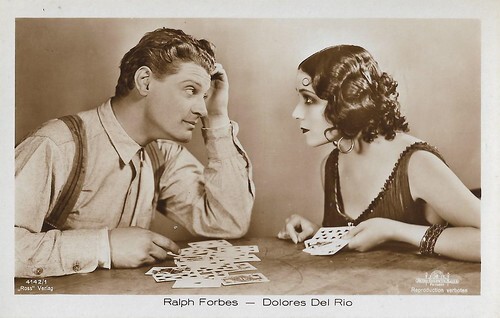
German postcard by Ross Verlag, no. 4142/1, 1929-1930. Photo: Metro-Goldwyn-Mayer. Ralph Forbes and Dolores del Rio in The Trail of '98 (Clarence Brown, 1928).
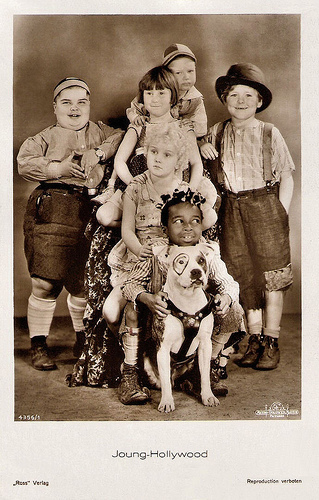
German postcard by Ross Verlag, no. 4356/1, 1929-1930. Photo: Metro-Goldwyn-Mayer. Our Gang .
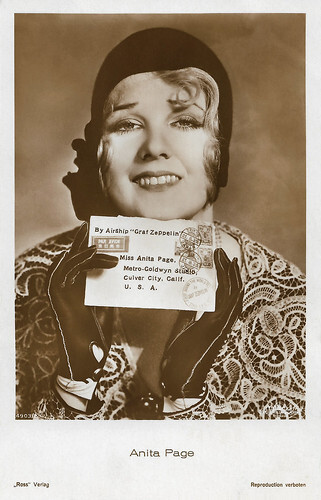
German postcard by Ross Verlag, no. 4903/2, 1929-1930. Photo: Metro-Goldwyn-Mayer. Anita Page .
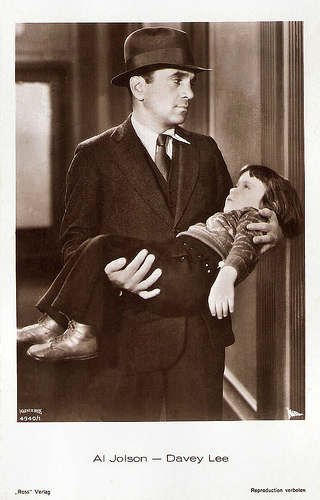
German postcard by Ross Verlag, no. 4940/1, 1929-1930. Photo: Warner Bros. / National. Publicity still for The Singing Fool (Lloyd Bacon, 1928) with Al Jolson and Davey Lee.
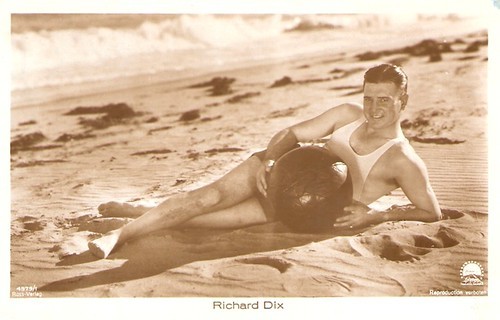
German postcard by Ross Verlag, no. 4979/1, 1929-1930. Photo: Paramount. Richard Dix .
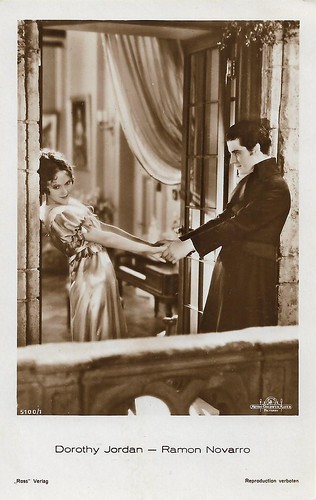
German postcard by Ross Verlag, no. 5100/1. Photo: Metro-Goldwyn-Mayer. Ramon Novarro and Dorothy Jordan in Devil-May-Care (Sidney Franklin, 1929). This was Ramon Novarro 's first sound picture.
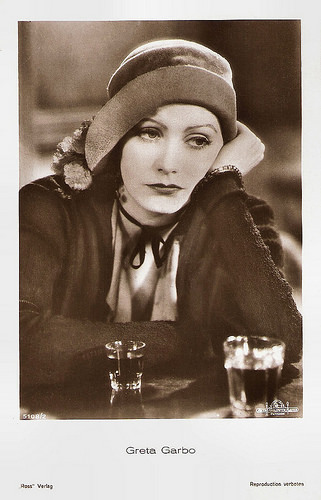
German postcard by Ross Verlag, no. 5108/2, 1930-1931. Photo: MGM. Publicity still for Anna Christie (Clarence Brown, 1930) featuring Greta Garbo .
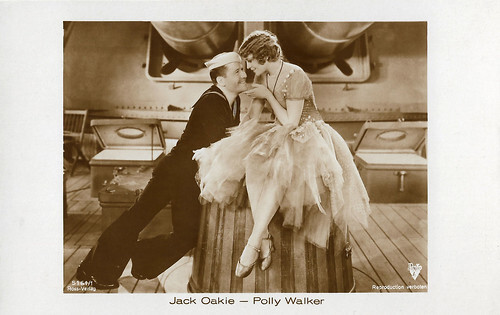
German postcard by Ross Verlag, no. 5161/1, 1930-1931. Photo: Radio. Jack Oakie and Polly Walker in Hit the Deck (Luther Reed, 1929).
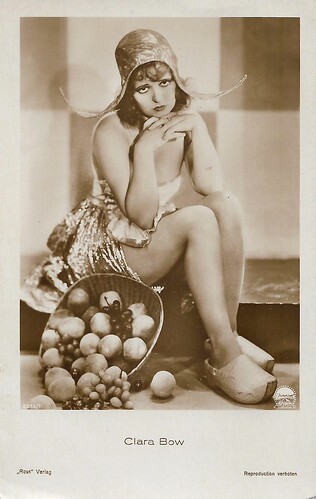
German postcard by Ross Verlag Berlin, no. 5393/1, 1930-1931. Photo: Paramount. Clara Bow .
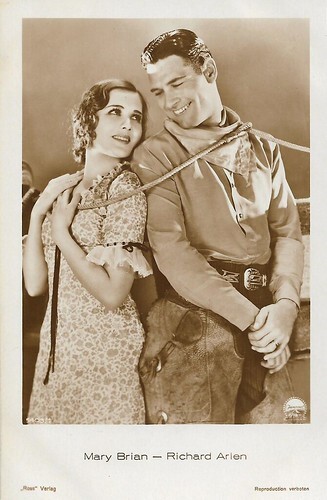
German postcard. by Ross Verlag, no. 5403/1, 1930-1931. Photo: Paramount. Mary Brian and Richard Arlen in The Light of the Western Stars (Otto Dyar, 1930).
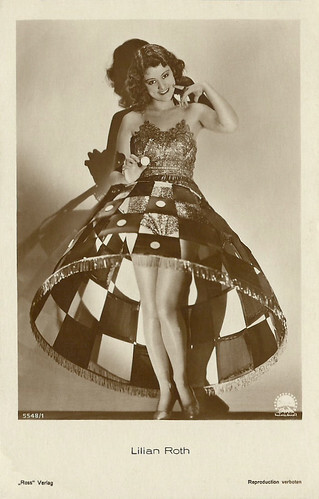
German postcard by Ross Verlag, no. 5548/1, 1930-1931. Photo: Paramount. Collection: Didier Hanson. Lillian Roth .
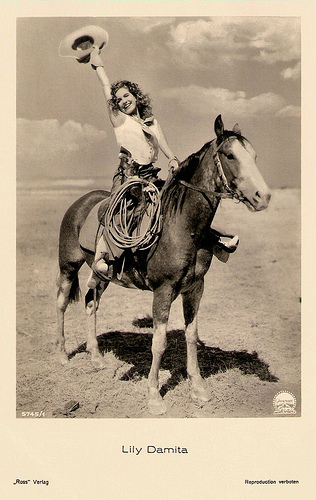
German postcard by Ross Verlag, no. 5745/1, 1930-1931. Photo: Paramount. Lily Damita in Fighting Caravans (Otto Brower, David Burton, 1931).
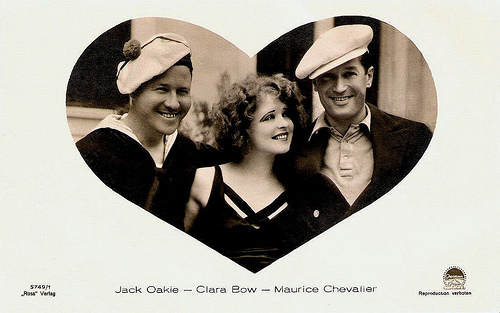
German postcard by Ross Verlag, no. 5749/1, 1930-1931. Photo: Paramount. Publicity still for Paramount on Parade (Dorothy Arzner a.o., 1930) with Jack Oakie , Clara Bow and Maurice Chevalier .
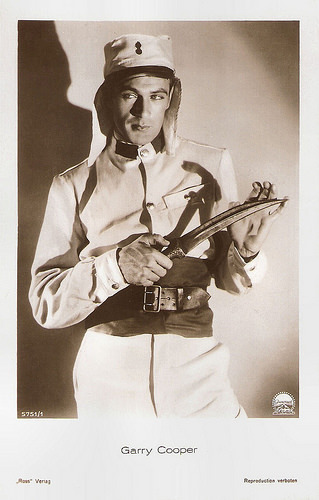
German postcard by Ross-Verlag, no. 5751/1, 1930-1931. Photo: Paramount. Publicity still for Morocco (Josef von Sternberg, 1930). Gary Cooper was mistakenly credited as 'Garry Cooper'.
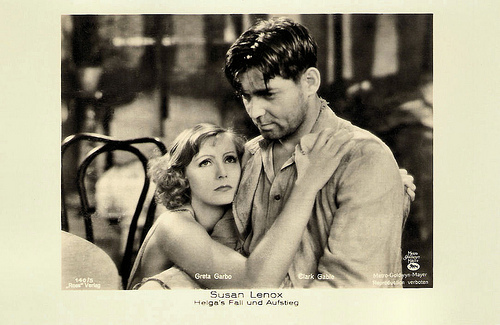
German postcard by Ross Verlag, no. 140/5. Photo: Metro-Goldwyn-Mayer. Publicity still for Susan Lenox (Robert Z. Leonard, 1931) with Greta Garbo and Clark Gable.
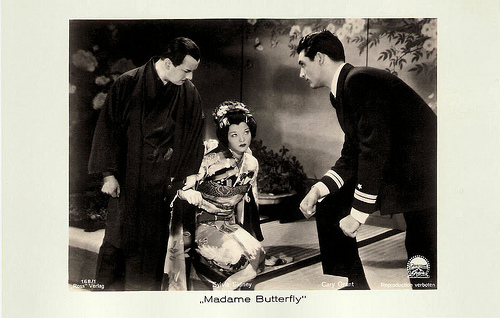
German postcard by Ross Verlag, no. 168/1. Photo: Paramount. Publicity still for Madame Butterfly (Marion Gering, 1932) with Sylvia Sidney and Cary Grant .
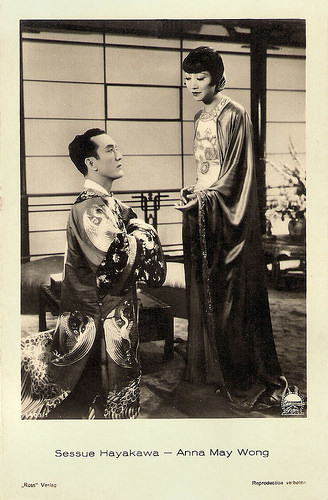
German postcard by Ross Verlag, no. 6403/1, 1931-1932. Photo: Paramount. Publicity still for Daughter of the Dragon (Lloyd Corrigan, 1931) with Anna May Wong and Sessue Hayakawa .
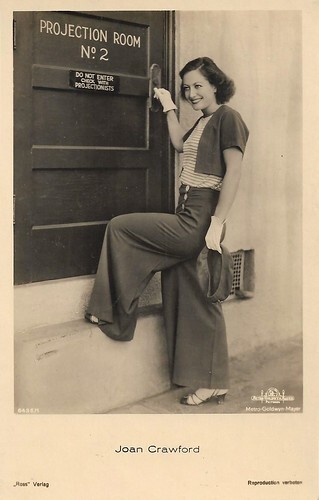
German postcard by Ross Verlag, no. 6436/1, 1931-1932. Photo: Metro-Goldwyn Mayer. Joan Crawford .
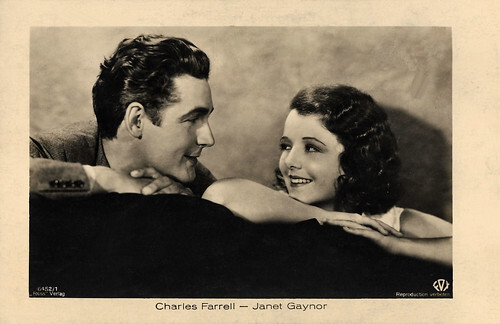
German postcard by Ross Verlag, no. 6452/1, 1931-1932. Photo: Fox. Publicity still for Delicious (David Butler, 1931) with Charles Farrell and Janet Gaynor .
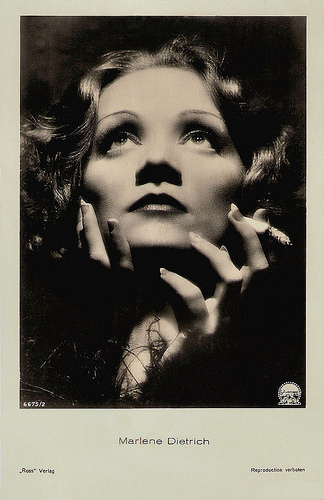
German postcard by Ross Verlag, no. 6673/2, 1931-1932. Photo: Don English / Paramount. Marlene Dietrich in Shanghai Express (Josef von Sternberg, 1932).
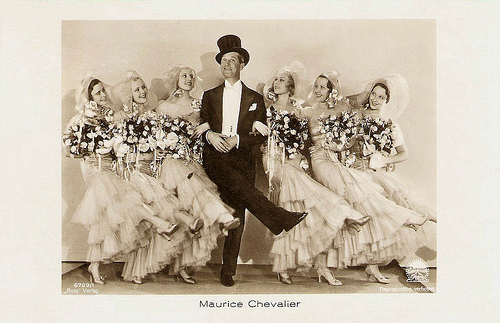
German postcard by Ross Verlag, no. 6709/1, 1931-1932. Photo: Paramount. Maurice Chevalier .
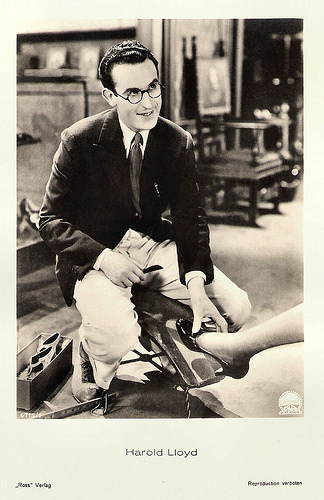
German postcard by Ross Verlag, no. 6715/1, 1931-1932. Photo: Paramount. Photo: publicity still for Feet First (Clyde Bruckman, 1930), starring Harold Lloyd .
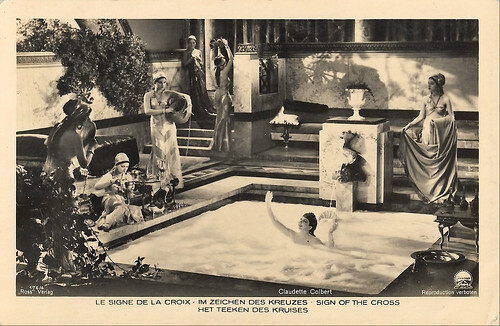
German postcard by Ross Verlag, no. 176/4. Photo: Paramount. Claudette Colbert in Sign of the Cross (Cecil B. DeMille, 1932).
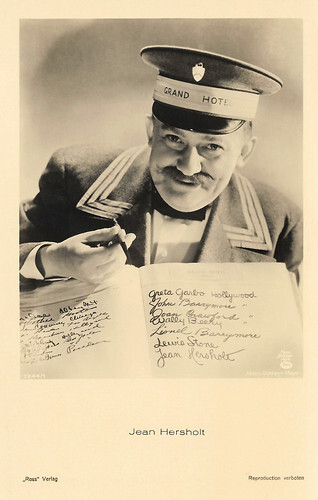
German postcard by Ross Verlag, no. 7244/1, 1932-1933, distributed in Italy by Casa Editrice Ballerini & Fratini, Firenze. Photo: Metro-Goldwyn-Mayer. Jean Hersholt in Grand Hotel (Edmund Goulding, 1932).
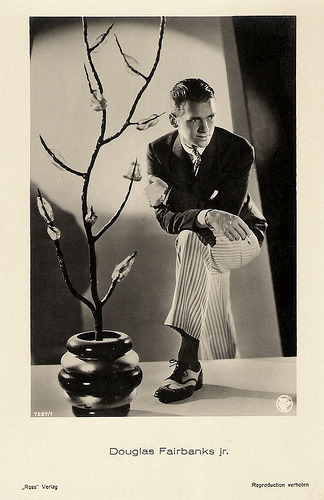
German postcard by Ross Verlag, no. 7297/1, 1932-1933. Photo: First National Pictures. Douglas Fairbanks Jr.
The Ross Verlag Tribute is to be continued next week.

German postcard by Ross Verlag, no. 4142/1, 1929-1930. Photo: Metro-Goldwyn-Mayer. Ralph Forbes and Dolores del Rio in The Trail of '98 (Clarence Brown, 1928).

German postcard by Ross Verlag, no. 4356/1, 1929-1930. Photo: Metro-Goldwyn-Mayer. Our Gang .

German postcard by Ross Verlag, no. 4903/2, 1929-1930. Photo: Metro-Goldwyn-Mayer. Anita Page .

German postcard by Ross Verlag, no. 4940/1, 1929-1930. Photo: Warner Bros. / National. Publicity still for The Singing Fool (Lloyd Bacon, 1928) with Al Jolson and Davey Lee.

German postcard by Ross Verlag, no. 4979/1, 1929-1930. Photo: Paramount. Richard Dix .

German postcard by Ross Verlag, no. 5100/1. Photo: Metro-Goldwyn-Mayer. Ramon Novarro and Dorothy Jordan in Devil-May-Care (Sidney Franklin, 1929). This was Ramon Novarro 's first sound picture.

German postcard by Ross Verlag, no. 5108/2, 1930-1931. Photo: MGM. Publicity still for Anna Christie (Clarence Brown, 1930) featuring Greta Garbo .

German postcard by Ross Verlag, no. 5161/1, 1930-1931. Photo: Radio. Jack Oakie and Polly Walker in Hit the Deck (Luther Reed, 1929).

German postcard by Ross Verlag Berlin, no. 5393/1, 1930-1931. Photo: Paramount. Clara Bow .

German postcard. by Ross Verlag, no. 5403/1, 1930-1931. Photo: Paramount. Mary Brian and Richard Arlen in The Light of the Western Stars (Otto Dyar, 1930).

German postcard by Ross Verlag, no. 5548/1, 1930-1931. Photo: Paramount. Collection: Didier Hanson. Lillian Roth .

German postcard by Ross Verlag, no. 5745/1, 1930-1931. Photo: Paramount. Lily Damita in Fighting Caravans (Otto Brower, David Burton, 1931).

German postcard by Ross Verlag, no. 5749/1, 1930-1931. Photo: Paramount. Publicity still for Paramount on Parade (Dorothy Arzner a.o., 1930) with Jack Oakie , Clara Bow and Maurice Chevalier .

German postcard by Ross-Verlag, no. 5751/1, 1930-1931. Photo: Paramount. Publicity still for Morocco (Josef von Sternberg, 1930). Gary Cooper was mistakenly credited as 'Garry Cooper'.

German postcard by Ross Verlag, no. 140/5. Photo: Metro-Goldwyn-Mayer. Publicity still for Susan Lenox (Robert Z. Leonard, 1931) with Greta Garbo and Clark Gable.

German postcard by Ross Verlag, no. 168/1. Photo: Paramount. Publicity still for Madame Butterfly (Marion Gering, 1932) with Sylvia Sidney and Cary Grant .

German postcard by Ross Verlag, no. 6403/1, 1931-1932. Photo: Paramount. Publicity still for Daughter of the Dragon (Lloyd Corrigan, 1931) with Anna May Wong and Sessue Hayakawa .

German postcard by Ross Verlag, no. 6436/1, 1931-1932. Photo: Metro-Goldwyn Mayer. Joan Crawford .

German postcard by Ross Verlag, no. 6452/1, 1931-1932. Photo: Fox. Publicity still for Delicious (David Butler, 1931) with Charles Farrell and Janet Gaynor .

German postcard by Ross Verlag, no. 6673/2, 1931-1932. Photo: Don English / Paramount. Marlene Dietrich in Shanghai Express (Josef von Sternberg, 1932).

German postcard by Ross Verlag, no. 6709/1, 1931-1932. Photo: Paramount. Maurice Chevalier .

German postcard by Ross Verlag, no. 6715/1, 1931-1932. Photo: Paramount. Photo: publicity still for Feet First (Clyde Bruckman, 1930), starring Harold Lloyd .

German postcard by Ross Verlag, no. 176/4. Photo: Paramount. Claudette Colbert in Sign of the Cross (Cecil B. DeMille, 1932).

German postcard by Ross Verlag, no. 7244/1, 1932-1933, distributed in Italy by Casa Editrice Ballerini & Fratini, Firenze. Photo: Metro-Goldwyn-Mayer. Jean Hersholt in Grand Hotel (Edmund Goulding, 1932).

German postcard by Ross Verlag, no. 7297/1, 1932-1933. Photo: First National Pictures. Douglas Fairbanks Jr.
The Ross Verlag Tribute is to be continued next week.
Published on September 24, 2024 22:00
September 23, 2024
Peter Voss
Peter Voss (1891-1979) was a German character actor and occasional leading man. Following military service in World War I, he first appeared on stage. He was often seen as bon vivants, titled landowners or sea captains. Voss never quite established himself as a major star.
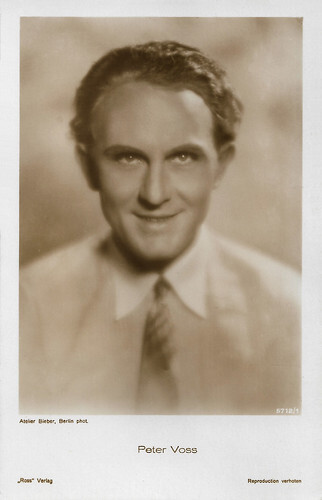
German postcard by Ross Verlag, no. 5712/1, 1930-1931. Photo: Atelier Bieber, Berlin.
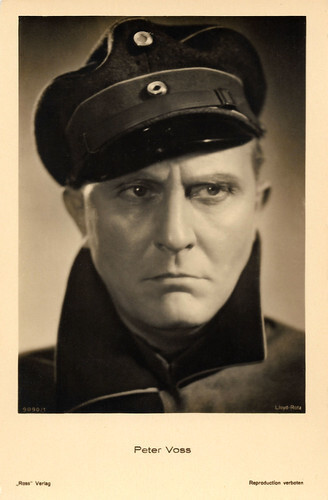
German postcard by Ross Verlag, no. 9090/1, 1935-1936. Photo: Lloyd - Rota. Peter Voss in Mein Leben für Maria Isabell/My Life for Maria Isabella (Erich Waschneck, 1935).
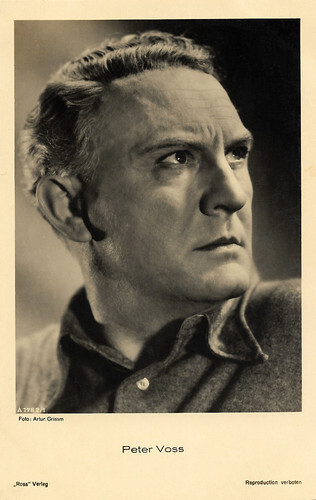
German postcard by Ross Verlag, no. A 1782/1, 1937-1938. Photo: Arthur Grimm.
A lover and bon vivant
Peter Voss or Voß was born Heinrich Voss in 1891 in Fiefhusen, today a district of the Schleswig-Holstein municipality of Barmissen. In 1897, he moved with his parents Eduard Christian and Emilie Voß and his six siblings to Quarnbek-Stampe. There his father had acquired a farm with an inn.
In 1906, his parents ran the 'Landkrug' inn in the village. Peter initially worked in a commercial business. From 1914 on, the then 23-year-old had to do his military service. He survived the four years as a soldier unscathed. Discharged from the army, he finally realised his dream and took acting lessons.
Voss made his debut at the Stadttheater Kiel in the 1919-1920 season. His career took him to the United Theatres of Bochum and Duisburg, and the Stadttheater Basel In 1927 he moved to Berlin, where he performed at various theatres. In 1925, Peter Voss made his film debut in the amusing comedy Liebe und Trompetenblasen/Love and Trumpets (Richard Eichberg, 1925) starring Lilian Harvey , Harry Liedtke , and Harry Halm . Seven more silent productions followed.
In the German-Swiss silent drama Der Kampf ums Matterhorn/Struggle for the Matterhorn (Mario Bonnard, Nunzio Malasomma, 1928) he played Edward Whymper opposite Luis Trenker and Marcella Albani . The film depicts the battle between British and Italian climbers to be the first to climb the Matterhorn and is part of the popular cycle of Mountain films of the 1920s and 1930s.
Peter Voss often appeared as a lover and bon vivant in such silent films as Katharina Knie (Karl Grune, 1929) starring Eugen Klöpfer and Carmen Boni , and Spielereien einer Kaiserin/The Ring of the Empress (Wladimir Strijewski, 1929) with Lil Dagover .
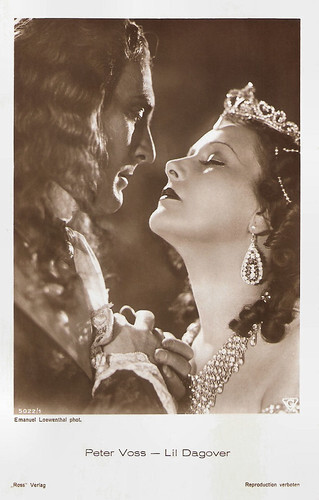
German postcard by Ross Verlag, no. 5022/1, 1930-1931. Photo: Emanuel Loewenthal, Berlin / Greenbaum-Film. Peter Voss and Lil Dagover in Spielereien einer Kaiserin/The Ring of the Empress (Wladimir Strijewski, 1930).
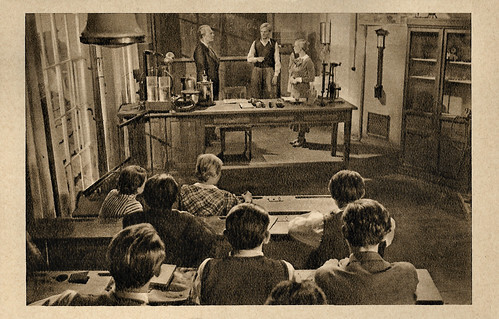
German postcard. Photo: Europa Verleih. Peter Voss, Albert Lieven and Hertha Thiele in Reifende Jugend/Ripening Youth (Carl Froehlich, 1933).
A dashing soldier in Nazi Propaganda films
Peter Voss appeared in the early sound film Zwei Welten/Two Worlds (Ewald André Dupont, 1930). In Grün ist die Heide/The Heath Is Green (Hans Behrendt, 1932), he was the leading actor as a young forester and partner of Camilla Spira. He also had a leading role in the drama Reifende Jugend/Ripening Youth (Carl Froelich, 1933) with Heinrich George and Hertha Thiele . It was well-received by the Nazi press on its release and drew inspiration from the earlier Madchen in Uniform/Girls in Uniform (Leontine Sagan, 1931) also with Thiele, which was admired by film journalists of the Third Reich.
Despite these and other leading roles, Voss never achieved the status of a film star like the similarly gifted Willy Fritsch . His portrayal of Death in the extremely dark film Fährmann Maria/Ferryman Maria (Frank Wisbar, 1935) starring Sybille Schmitz , was unusual. He also played Lord Henry Baskerville in the Sherlock Holmes crime film Der Hund von Baskerville/The Hound of the Baskervilles (Karl Lamac, 1937) with Bruno Güttner as Sherlock Holmes and Fritz Odemar as Dr Watson.
In the following years, Voß appeared as a dashing soldier in a series of Nazi Propaganda films. He played British officer Captain Cunningham in Alarm in Peking (1937), set at the time of the Boxer Rebellion in China in 1900 and played Major Hagen in Kampfgeschwader Lützow (1941). Both productions are still counted among the so-called 'reserved films'. He also had a small role in the Propaganda film Titanic (Herbert Selpin, 1943) depicting the catastrophic sinking of the RMS Titanic in 1912.
The actor was then drafted as a soldier and spent the end of the war in captivity. After his release and the war's end, he mainly acted in the theatre and took on a few roles in films such as Wenn die Abendglocken läuten/When the Evening Bells Ring (Alfred Braun, 1951) with Willy Birgel . His final film was the war drama Nacht fiel über Gotenhafen/Darkness Fell on Gotenhafen (Frank Wisbar, 1959) starring Sonja Ziemann . The film dramatizes the sinking of MV Wilhelm Gustloff, which was sunk after a Soviet torpedo attack while carrying German servicemen and around 6,000 civilian evacuees. He played the ship captain.
After losing his flat in Berlin during the war, Voss spent the rest of his life with his younger brother Paul Voss in Quarnbek-Stampe. There Paul ran their parents' pub 'Landkrug' from 1922 until he died in 1954. Peter Voß had learnt milking and beer tapping from his brother and turned the garden of the Landkrug into a piece of jewellery. Peter Voss died of pneumonia in 1979 in Nortorf, near Kiel in Schleswig-Holstein. He was 87.
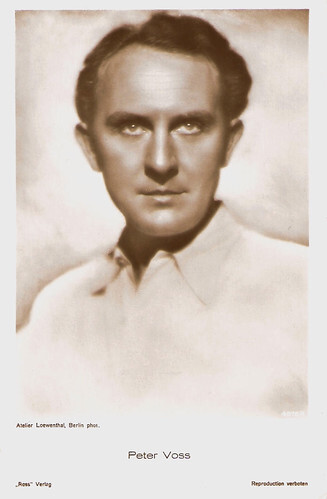
German postcard by Ross Verlag, no. 4878/1, 1929-1930. Photo: Loewenthal, Berlin.
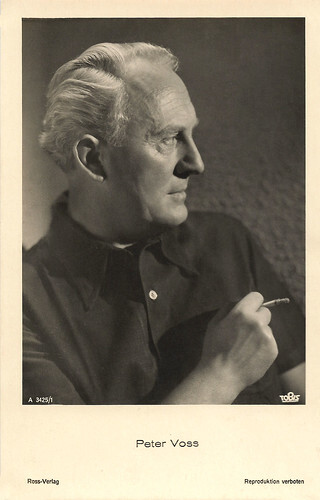
German postcard by Ross Verlag, no. A 3415/1, 1941-1944. Photo: Tobis.
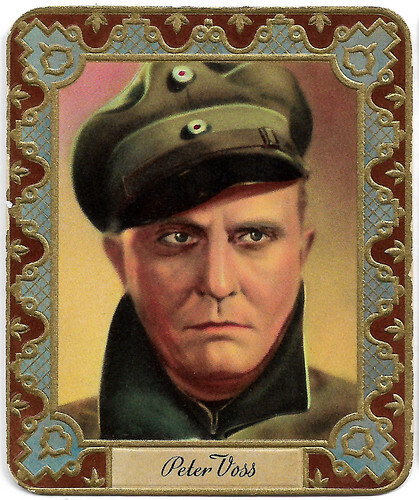
German collector card by Ross Verlag in the Moderne Schonheitsgalerie, Series 2, no. 257, issued by Kur Mark Cigarettes. Photo: Lloyd - Rota. Peter Voss in Mein Leben für Maria Isabell/My Life for Maria Isabella (Erich Waschneck, 1935).
Sources: Wikipedia (German) and .

German postcard by Ross Verlag, no. 5712/1, 1930-1931. Photo: Atelier Bieber, Berlin.

German postcard by Ross Verlag, no. 9090/1, 1935-1936. Photo: Lloyd - Rota. Peter Voss in Mein Leben für Maria Isabell/My Life for Maria Isabella (Erich Waschneck, 1935).

German postcard by Ross Verlag, no. A 1782/1, 1937-1938. Photo: Arthur Grimm.
A lover and bon vivant
Peter Voss or Voß was born Heinrich Voss in 1891 in Fiefhusen, today a district of the Schleswig-Holstein municipality of Barmissen. In 1897, he moved with his parents Eduard Christian and Emilie Voß and his six siblings to Quarnbek-Stampe. There his father had acquired a farm with an inn.
In 1906, his parents ran the 'Landkrug' inn in the village. Peter initially worked in a commercial business. From 1914 on, the then 23-year-old had to do his military service. He survived the four years as a soldier unscathed. Discharged from the army, he finally realised his dream and took acting lessons.
Voss made his debut at the Stadttheater Kiel in the 1919-1920 season. His career took him to the United Theatres of Bochum and Duisburg, and the Stadttheater Basel In 1927 he moved to Berlin, where he performed at various theatres. In 1925, Peter Voss made his film debut in the amusing comedy Liebe und Trompetenblasen/Love and Trumpets (Richard Eichberg, 1925) starring Lilian Harvey , Harry Liedtke , and Harry Halm . Seven more silent productions followed.
In the German-Swiss silent drama Der Kampf ums Matterhorn/Struggle for the Matterhorn (Mario Bonnard, Nunzio Malasomma, 1928) he played Edward Whymper opposite Luis Trenker and Marcella Albani . The film depicts the battle between British and Italian climbers to be the first to climb the Matterhorn and is part of the popular cycle of Mountain films of the 1920s and 1930s.
Peter Voss often appeared as a lover and bon vivant in such silent films as Katharina Knie (Karl Grune, 1929) starring Eugen Klöpfer and Carmen Boni , and Spielereien einer Kaiserin/The Ring of the Empress (Wladimir Strijewski, 1929) with Lil Dagover .

German postcard by Ross Verlag, no. 5022/1, 1930-1931. Photo: Emanuel Loewenthal, Berlin / Greenbaum-Film. Peter Voss and Lil Dagover in Spielereien einer Kaiserin/The Ring of the Empress (Wladimir Strijewski, 1930).

German postcard. Photo: Europa Verleih. Peter Voss, Albert Lieven and Hertha Thiele in Reifende Jugend/Ripening Youth (Carl Froehlich, 1933).
A dashing soldier in Nazi Propaganda films
Peter Voss appeared in the early sound film Zwei Welten/Two Worlds (Ewald André Dupont, 1930). In Grün ist die Heide/The Heath Is Green (Hans Behrendt, 1932), he was the leading actor as a young forester and partner of Camilla Spira. He also had a leading role in the drama Reifende Jugend/Ripening Youth (Carl Froelich, 1933) with Heinrich George and Hertha Thiele . It was well-received by the Nazi press on its release and drew inspiration from the earlier Madchen in Uniform/Girls in Uniform (Leontine Sagan, 1931) also with Thiele, which was admired by film journalists of the Third Reich.
Despite these and other leading roles, Voss never achieved the status of a film star like the similarly gifted Willy Fritsch . His portrayal of Death in the extremely dark film Fährmann Maria/Ferryman Maria (Frank Wisbar, 1935) starring Sybille Schmitz , was unusual. He also played Lord Henry Baskerville in the Sherlock Holmes crime film Der Hund von Baskerville/The Hound of the Baskervilles (Karl Lamac, 1937) with Bruno Güttner as Sherlock Holmes and Fritz Odemar as Dr Watson.
In the following years, Voß appeared as a dashing soldier in a series of Nazi Propaganda films. He played British officer Captain Cunningham in Alarm in Peking (1937), set at the time of the Boxer Rebellion in China in 1900 and played Major Hagen in Kampfgeschwader Lützow (1941). Both productions are still counted among the so-called 'reserved films'. He also had a small role in the Propaganda film Titanic (Herbert Selpin, 1943) depicting the catastrophic sinking of the RMS Titanic in 1912.
The actor was then drafted as a soldier and spent the end of the war in captivity. After his release and the war's end, he mainly acted in the theatre and took on a few roles in films such as Wenn die Abendglocken läuten/When the Evening Bells Ring (Alfred Braun, 1951) with Willy Birgel . His final film was the war drama Nacht fiel über Gotenhafen/Darkness Fell on Gotenhafen (Frank Wisbar, 1959) starring Sonja Ziemann . The film dramatizes the sinking of MV Wilhelm Gustloff, which was sunk after a Soviet torpedo attack while carrying German servicemen and around 6,000 civilian evacuees. He played the ship captain.
After losing his flat in Berlin during the war, Voss spent the rest of his life with his younger brother Paul Voss in Quarnbek-Stampe. There Paul ran their parents' pub 'Landkrug' from 1922 until he died in 1954. Peter Voß had learnt milking and beer tapping from his brother and turned the garden of the Landkrug into a piece of jewellery. Peter Voss died of pneumonia in 1979 in Nortorf, near Kiel in Schleswig-Holstein. He was 87.

German postcard by Ross Verlag, no. 4878/1, 1929-1930. Photo: Loewenthal, Berlin.

German postcard by Ross Verlag, no. A 3415/1, 1941-1944. Photo: Tobis.

German collector card by Ross Verlag in the Moderne Schonheitsgalerie, Series 2, no. 257, issued by Kur Mark Cigarettes. Photo: Lloyd - Rota. Peter Voss in Mein Leben für Maria Isabell/My Life for Maria Isabella (Erich Waschneck, 1935).
Sources: Wikipedia (German) and .
Published on September 23, 2024 22:00
September 22, 2024
Tala Birell
Austrian actress Tala Birell (1907-1958) was a protégé of legendary stage director Max Reinhardt and became popular in his Viennese productions. Universal signed her to star in Hollywood films and the studio built her up as a new Garbo. To no avail. During the 1940s and early 1950s, she mainly worked in B-films and for TV.
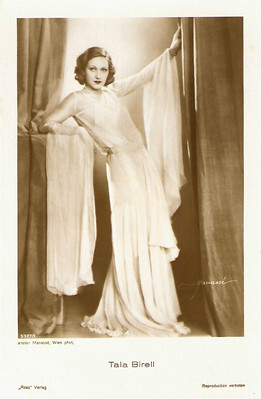
German postcard by Ross Verlag, Berlin, no. 5327/1, 1930-1931. Photo: Manassé, Wien.
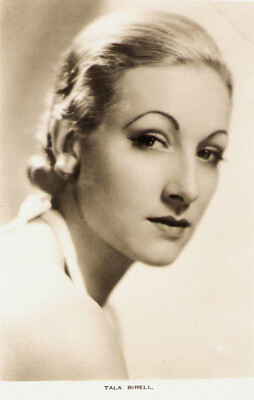
British postcard in the Film Weekly Series, London.
One of the ten best films of 1932
Tall and blond Tala Birell was born Natalie Bierl in Bucharest, Romania in 1907. Her mother Stephanie Sahaydakowska, was a Polish baroness, and her father, Carl Bierl, was an Austrian businessman. They were temporarily in Bucharest while he was overseeing his company there. Nathalie and her three sisters and one brother enjoyed an idyllic life, summering at the Polish estate of her aristocratic uncle.
During WWI the family was in Berlin, where Nathalie studied at a private school. After the war her father died and her privileged childhood came to an end. She dreamed of the theatre and made her stage debut in Berlin in 1926 in 'The Mikado' with Erik Charell. That year, she also made her film debut credited as Thala Birell in a bit role in Man spielt nicht mit der Liebe/One Does Not Play with Love (Georg Wilhelm Pabst, 1926), starring Werner Krauss and Lili Damita . This silent German drama was an adaptation of the play 'On ne badine pas avec l'amour' by Alfred de Musset and is now considered to be a lost film.
The following year she played in Ich habe im Mai von der Liebe geträumt/In May, I dreamed of love (Frans Seitz, 1927) with Wilhelm Dieterle . She was spotted by the famous stage producer Max Reinhardt , who put her in his production of 'Es Liegt in Der Luft' (It’s in the Air, 1927) starring Marlene Dietrich . Birell was an understudy for Dietrich’s role until Dietrich left the show. Tala then became the star and took the show to Vienna. As a Reinhardt protégé, her appearances and her reputation grew. In Austria, she played the female lead in the film Die Tat des Andreas Harmer/The Act of Andrew Harmer (Alfred Deutsch, 1930).
Next, she went to England to appear in the drama Menschen im Käfig/The Love Storm (Ewald André Dupont, 1930) starring Conrad Veidt . This was the German-language version of the British film Cape Forlorn (Ewald André Dupont, 1931). Then, a Universal executive signed her to come to Hollywood for a part in Liebe auf Befehl (Ernst L. Frank, Johannes Riemann, 1931), the German version of The Boudoir Diplomat (Malcolm St. Clair, 1930) with Betty Compson . She stayed in Hollywood and Universal gave her a leading role in Doomed Battalion (Cyril Gardner, 1932), the American version of a German mountain film starring Luis Trenker . It was a critical and artistic success and was voted one of the ten best films of 1932 by the New York Times.
Then she appeared as a European countess in Nagana (Ernst L. Frank, 1933) opposite Melvyn Douglas . The studio promoted her as a second Garbo, due to her glamorous, a bit cold beauty. But just as with another European import Anna Sten , the publicity did not work. Garbo was unique. In the following years, Tirell only played small roles for Columbia Pictures in films like The Captain Hates the Sea (Lewis Milestone, 1934). She got the female lead in B-films like the aviation-themed Science-Fiction film Air Hawks (Albert Rogell, 1935). She also had supporting parts in A-films like the musical comedy Let's Live Tonight (Victor Schertzinger, 1935) starring Lilian Harvey , Crime and Punishment (Josef von Sternberg, 1935) starring Peter Lorre , and the classic screwball comedy Bringing Up Baby (Howard Hawks, 1938).
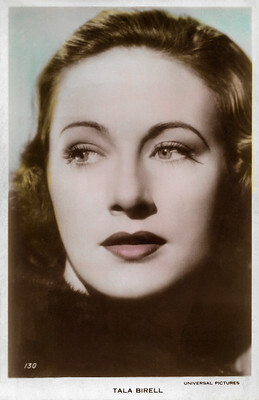
British Art Photo postcard, no. 130. Photo: Universal Pictures.
Poverty row studios
In 1940 Tala Birell appeared onstage in 'My Dear Children' at the Belasco Theatre in New York City. During the 1940s she continued to appear in B-films like the action film Seven Miles from Alcatraz (Edward Dmytryk, 1942) with Bonita Granville , and One Dangerous Night (Michael Gordon, 1943), the ninth Lone Wolf film featuring Warren William as former jewel thief and reformed detective Michael Lanyard alias The Lone Wolf.
Her most often-seen performance is her brief role as the governess to the Empress's very young son in The Song of Bernadette (Henry King, 1943), who takes what is believed to be miraculous water from the grotto. Her roles got smaller and she started to work for ‘poverty row’ studios such as PRC and Monogram Pictures. For PRC she played in the Science Fiction/Horror movie The Monster Maker (Sam Newfield, 1944) starring J. Carrol Naish.
For Columbia, she played in a film of another popular series, the Mystery Film Noir The Power of the Whistler (Lew Landers, 1945) based on the radio drama 'The Whistler'. Several of her characters were linked with the anti-Nazi war effort: a courageous Russian in China (John Farrow, 1943), Madame Bouchard of the French Resistance in Till We Meet Again (Frank Borzage, 1944), the Nazi Doctor Elise Bork in the serial Jungle Queen (Lewis D. Collins, Ray Taylor, 1945), and Yvette Aubert, the French adventurer and entertainer in Women in the Night (William Rowland, 1948), who plays along with an extreme Nazi unit in Shanghai until she saves the world from a weapon of mass destruction with the sacrifice of her life.
After the war, she also had a small part in the biopic Song of Love (Clarence Brown, 1947) starring Katharine Hepburn as Clara Wieck. Tirell returned to Germany and took up residence with her mother who was by then living in Munich. In 1951 she was appointed by the Special Service Headquarters of the U.S. Army in Nuremberg to organise theatrical productions in Germany, France, and Austria for the G.I.s stationed there. Her title was Field Entertainment Supervisor and sometimes, she took part in shows at military clubs in Munich, Nuremberg, and Orléans (France).
She later moved to Berlin with the title Command Entertainment Director and put on shows for U.S. troops and refugees from Eastern Europe. She retired in 1957 for health reasons. Her final on-camera appearance was as the Queen of Cygni in an episode of the television series Flash Gordon (1955), based on the characters of the Alex Raymond-created comic strip. Tala Birell died in 1958 in Landstuhl, Germany, aged 50. She was buried in the Bavarian village Marquartstein in a family tomb.
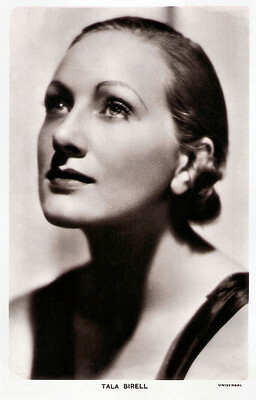
British postcard in the Picturegoer Series, no. 774. Photo: Universal.
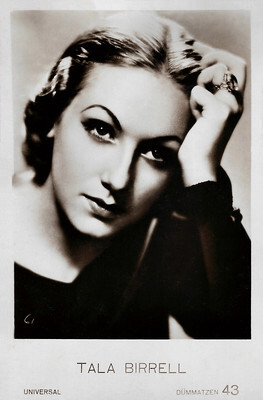
Spanish postcard by Dümmatzen, no. 43. Photo: Universal.
Sources: L. Paul Meienberg (Films of the Golden Age - now defunct), Hal Erickson (All Movie - page now defunct), Wikipedia and .

German postcard by Ross Verlag, Berlin, no. 5327/1, 1930-1931. Photo: Manassé, Wien.

British postcard in the Film Weekly Series, London.
One of the ten best films of 1932
Tall and blond Tala Birell was born Natalie Bierl in Bucharest, Romania in 1907. Her mother Stephanie Sahaydakowska, was a Polish baroness, and her father, Carl Bierl, was an Austrian businessman. They were temporarily in Bucharest while he was overseeing his company there. Nathalie and her three sisters and one brother enjoyed an idyllic life, summering at the Polish estate of her aristocratic uncle.
During WWI the family was in Berlin, where Nathalie studied at a private school. After the war her father died and her privileged childhood came to an end. She dreamed of the theatre and made her stage debut in Berlin in 1926 in 'The Mikado' with Erik Charell. That year, she also made her film debut credited as Thala Birell in a bit role in Man spielt nicht mit der Liebe/One Does Not Play with Love (Georg Wilhelm Pabst, 1926), starring Werner Krauss and Lili Damita . This silent German drama was an adaptation of the play 'On ne badine pas avec l'amour' by Alfred de Musset and is now considered to be a lost film.
The following year she played in Ich habe im Mai von der Liebe geträumt/In May, I dreamed of love (Frans Seitz, 1927) with Wilhelm Dieterle . She was spotted by the famous stage producer Max Reinhardt , who put her in his production of 'Es Liegt in Der Luft' (It’s in the Air, 1927) starring Marlene Dietrich . Birell was an understudy for Dietrich’s role until Dietrich left the show. Tala then became the star and took the show to Vienna. As a Reinhardt protégé, her appearances and her reputation grew. In Austria, she played the female lead in the film Die Tat des Andreas Harmer/The Act of Andrew Harmer (Alfred Deutsch, 1930).
Next, she went to England to appear in the drama Menschen im Käfig/The Love Storm (Ewald André Dupont, 1930) starring Conrad Veidt . This was the German-language version of the British film Cape Forlorn (Ewald André Dupont, 1931). Then, a Universal executive signed her to come to Hollywood for a part in Liebe auf Befehl (Ernst L. Frank, Johannes Riemann, 1931), the German version of The Boudoir Diplomat (Malcolm St. Clair, 1930) with Betty Compson . She stayed in Hollywood and Universal gave her a leading role in Doomed Battalion (Cyril Gardner, 1932), the American version of a German mountain film starring Luis Trenker . It was a critical and artistic success and was voted one of the ten best films of 1932 by the New York Times.
Then she appeared as a European countess in Nagana (Ernst L. Frank, 1933) opposite Melvyn Douglas . The studio promoted her as a second Garbo, due to her glamorous, a bit cold beauty. But just as with another European import Anna Sten , the publicity did not work. Garbo was unique. In the following years, Tirell only played small roles for Columbia Pictures in films like The Captain Hates the Sea (Lewis Milestone, 1934). She got the female lead in B-films like the aviation-themed Science-Fiction film Air Hawks (Albert Rogell, 1935). She also had supporting parts in A-films like the musical comedy Let's Live Tonight (Victor Schertzinger, 1935) starring Lilian Harvey , Crime and Punishment (Josef von Sternberg, 1935) starring Peter Lorre , and the classic screwball comedy Bringing Up Baby (Howard Hawks, 1938).

British Art Photo postcard, no. 130. Photo: Universal Pictures.
Poverty row studios
In 1940 Tala Birell appeared onstage in 'My Dear Children' at the Belasco Theatre in New York City. During the 1940s she continued to appear in B-films like the action film Seven Miles from Alcatraz (Edward Dmytryk, 1942) with Bonita Granville , and One Dangerous Night (Michael Gordon, 1943), the ninth Lone Wolf film featuring Warren William as former jewel thief and reformed detective Michael Lanyard alias The Lone Wolf.
Her most often-seen performance is her brief role as the governess to the Empress's very young son in The Song of Bernadette (Henry King, 1943), who takes what is believed to be miraculous water from the grotto. Her roles got smaller and she started to work for ‘poverty row’ studios such as PRC and Monogram Pictures. For PRC she played in the Science Fiction/Horror movie The Monster Maker (Sam Newfield, 1944) starring J. Carrol Naish.
For Columbia, she played in a film of another popular series, the Mystery Film Noir The Power of the Whistler (Lew Landers, 1945) based on the radio drama 'The Whistler'. Several of her characters were linked with the anti-Nazi war effort: a courageous Russian in China (John Farrow, 1943), Madame Bouchard of the French Resistance in Till We Meet Again (Frank Borzage, 1944), the Nazi Doctor Elise Bork in the serial Jungle Queen (Lewis D. Collins, Ray Taylor, 1945), and Yvette Aubert, the French adventurer and entertainer in Women in the Night (William Rowland, 1948), who plays along with an extreme Nazi unit in Shanghai until she saves the world from a weapon of mass destruction with the sacrifice of her life.
After the war, she also had a small part in the biopic Song of Love (Clarence Brown, 1947) starring Katharine Hepburn as Clara Wieck. Tirell returned to Germany and took up residence with her mother who was by then living in Munich. In 1951 she was appointed by the Special Service Headquarters of the U.S. Army in Nuremberg to organise theatrical productions in Germany, France, and Austria for the G.I.s stationed there. Her title was Field Entertainment Supervisor and sometimes, she took part in shows at military clubs in Munich, Nuremberg, and Orléans (France).
She later moved to Berlin with the title Command Entertainment Director and put on shows for U.S. troops and refugees from Eastern Europe. She retired in 1957 for health reasons. Her final on-camera appearance was as the Queen of Cygni in an episode of the television series Flash Gordon (1955), based on the characters of the Alex Raymond-created comic strip. Tala Birell died in 1958 in Landstuhl, Germany, aged 50. She was buried in the Bavarian village Marquartstein in a family tomb.

British postcard in the Picturegoer Series, no. 774. Photo: Universal.

Spanish postcard by Dümmatzen, no. 43. Photo: Universal.
Sources: L. Paul Meienberg (Films of the Golden Age - now defunct), Hal Erickson (All Movie - page now defunct), Wikipedia and .
Published on September 22, 2024 22:00
September 21, 2024
La preda (1921)
La preda/The Prey (Guglielmo Zorzi, 1921) was an Italian silent melodrama starring diva Maria Jacobini, Amleto Novelli and the young Carmen Boni.
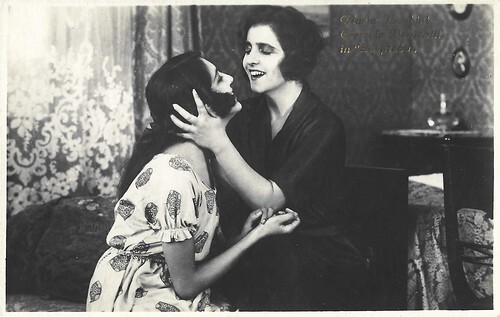
Italian postcard by G.B. Falci, Milano, no. 33. Photo: Fotominio. Maria Jacobini and Carmela Bonicatti ( Carmen Boni ) in La preda (1921).
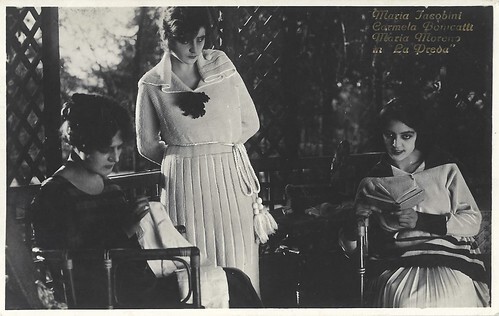
Italian postcard by G.B. Falci, Milano, no. 34. Photo: Maria Jacobini , Carmela Bonicatti ( Carmen Boni ) and Maria Moreno in La preda (1921).
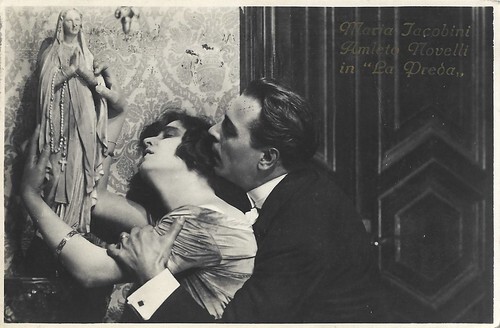
Italian postcard by G.B. Falci, Milano, no. 46. Photo: Fotominio. Publicity still for La preda (1921) with Maria Jacobini and Amleto Novelli .
She doesn't hesitate and kills him
The script of La preda/The Prey (Guglielmo Zorzi, 1921) was written by French screen writer and film director Camille de Morlhon. From 1908 to 1912, he was a prolific director, making over a hundred films for the Pathé company. Pathé sent him to Algeria to shoot a few films, and when he returned to France in 1912, he founded his own production company, Les Films Valetta. He was one of the first directors to sign his films, and in 1917 he founded the Société des auteurs de films to defend authors.
Italian writer and film director Guglielmo Zorzi directed La preda/The Prey for the Fert company. He was one of the most important and active playwrights in the inter-war period. His comedies generally dealt with problems of morality and psychology, which was particularly evident in 'La vena d'oro' (1919), his most successful comedy. In 1914, he was hired by Milano Films as art director and director. He also worked for other film companies such as Cines, Silentium Film and Fert. Zorzi directed around thirty films in the silent period,
In La preda/The Prey, the explorer Cesare Colleoni ( Amleto Novelli ) returns to Italy after a long stay in Africa. At his father's place, he meets his three cousins Anna (Mara Cassano), Maria ( Maria Jacobini ) and Gioietta (Carmela Bonicatti aka Carmen Boni ), whom he all courts at the same time.
He gets engaged with Anna, but right on the day before his wedding, he tries to seduce Maria. She resists, though. Afterwards, when Cesare has married Anna, Maria discovers he has managed her youngest sister Gioietta to hopefully fall in love with him and want to elope with him. Maria doesn't hesitate and kills Cesare.
Other cast members of La preda/The Prey were well-known Italian actors as Ida Carloni Talli , Alfonso Cassini, Lido Manetti and Augusto Mastripietri.
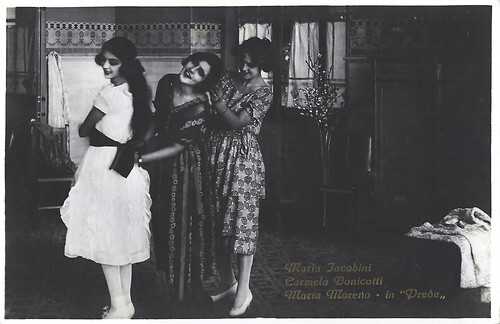
Italian postcard by G.B. Falci, Milano, no. 51. Photo: Fotominio. Maria Jacobini , Carmen Boni and Maria Moreno in La preda/The Prey (Gugielmo Zorzi, 1921).
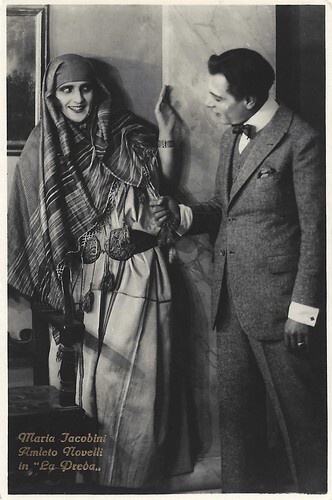
Italian postcard by G.B. Falci, Milano, no. 51. Photo: Fotominio. Maria Jacobini and Amleto Novelli in La preda (1921).
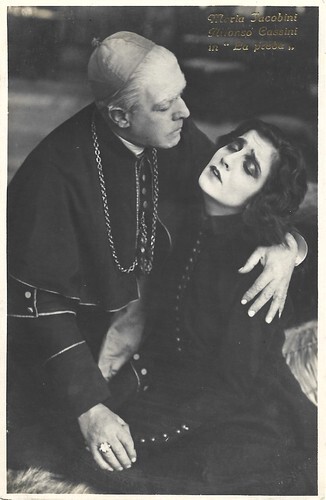
Italian postcard by G.B. Falci, Milano, no. 153. Photo: Maria Jacobini and Alfonso Cassini in La preda (1921).
The interior dilemma of the female protagonist
La preda/The Prey (Guglielmo Zorzi, 1921) was produced by Fert, a film studio founded in Turin by Enrico Fiori in 1919. The Fiori Enrico Roma Torino studio (hence the acronym Fert) was one of the most important Italian studios until the appearance of sound. The studio produced mostly B-films in the sound era. Till 1973, Fert produced 180 films.
In 1920, Fert had hired Maria Jacobini as ‘prima actress’. At Fert, she became professionally and emotionally bound to Gennaro Righelli, one of the most important Italian film directors of the time. With him she had a son Angelo Jacobini in 1921 and in 1925 they married. There were numerous films in which she was directed by Righelli, including Amore rosso/Red Love (1921), Il viaggio/The Voyage (1921) and L'isola e il continente/The Island And The Continent (1922).
La preda/The Prey premiered on 10 January 1922, in Rome. The Naples journal La Cine-fono praised Maria Jacobini 's acting but the critic thought the characters were not individualised enough and the script had better be used for a stage play, where the interior dilemma of the female protagonist would have been expressed better.
Instead, the Turin journal La vita cinematografica praised both director and actors - Maria Jacobini in the first place - and thought that only the cinematography could have been better.
While film historian Vittorio Martinelli mentions Mara Cassano playing Anna, one postcard suggests this could have been Maria Moreno. Although both English Wikipedia and IMDb claim that La preda is a French-Italian coproduction, the production company, Fert was an Italian studio. Italian Wikipedia and Vittorio Martinelli write that it's an Italian production.
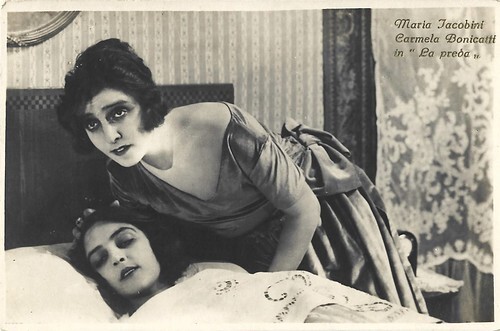
Italian postcard by G.B. Falci, Milano, no. 154. Photo: Maria Jacobini and Carmela Bonicatti ( Carmen Boni ) in La preda (1921).
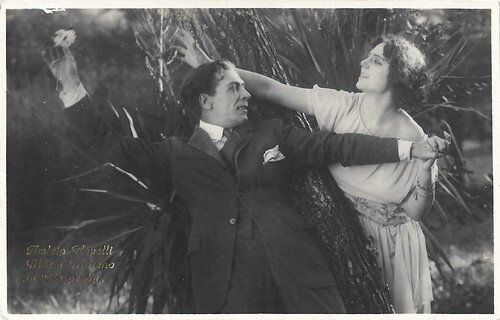
Italian postcard by G.B. Falci, Milano, no. 191. Photo: Amleto Novelli and Maria Moreno in La preda (1921).
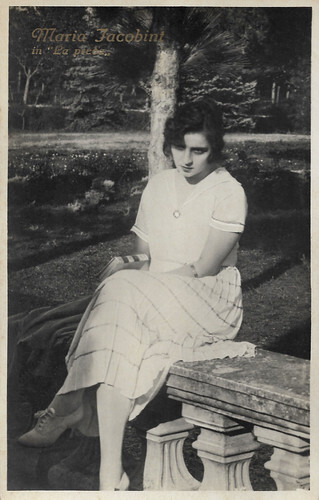
Italian postcard by G.B. Falci, Milano, no. 315. Photo: Maria Jacobini in La preda (1921).
Sources: Vittorio Martinelli (Il cinema muto italiano: I film degli anni venti, 1921 - Italian), Wikipedia (English and Italian) and IMDb.

Italian postcard by G.B. Falci, Milano, no. 33. Photo: Fotominio. Maria Jacobini and Carmela Bonicatti ( Carmen Boni ) in La preda (1921).

Italian postcard by G.B. Falci, Milano, no. 34. Photo: Maria Jacobini , Carmela Bonicatti ( Carmen Boni ) and Maria Moreno in La preda (1921).

Italian postcard by G.B. Falci, Milano, no. 46. Photo: Fotominio. Publicity still for La preda (1921) with Maria Jacobini and Amleto Novelli .
She doesn't hesitate and kills him
The script of La preda/The Prey (Guglielmo Zorzi, 1921) was written by French screen writer and film director Camille de Morlhon. From 1908 to 1912, he was a prolific director, making over a hundred films for the Pathé company. Pathé sent him to Algeria to shoot a few films, and when he returned to France in 1912, he founded his own production company, Les Films Valetta. He was one of the first directors to sign his films, and in 1917 he founded the Société des auteurs de films to defend authors.
Italian writer and film director Guglielmo Zorzi directed La preda/The Prey for the Fert company. He was one of the most important and active playwrights in the inter-war period. His comedies generally dealt with problems of morality and psychology, which was particularly evident in 'La vena d'oro' (1919), his most successful comedy. In 1914, he was hired by Milano Films as art director and director. He also worked for other film companies such as Cines, Silentium Film and Fert. Zorzi directed around thirty films in the silent period,
In La preda/The Prey, the explorer Cesare Colleoni ( Amleto Novelli ) returns to Italy after a long stay in Africa. At his father's place, he meets his three cousins Anna (Mara Cassano), Maria ( Maria Jacobini ) and Gioietta (Carmela Bonicatti aka Carmen Boni ), whom he all courts at the same time.
He gets engaged with Anna, but right on the day before his wedding, he tries to seduce Maria. She resists, though. Afterwards, when Cesare has married Anna, Maria discovers he has managed her youngest sister Gioietta to hopefully fall in love with him and want to elope with him. Maria doesn't hesitate and kills Cesare.
Other cast members of La preda/The Prey were well-known Italian actors as Ida Carloni Talli , Alfonso Cassini, Lido Manetti and Augusto Mastripietri.

Italian postcard by G.B. Falci, Milano, no. 51. Photo: Fotominio. Maria Jacobini , Carmen Boni and Maria Moreno in La preda/The Prey (Gugielmo Zorzi, 1921).

Italian postcard by G.B. Falci, Milano, no. 51. Photo: Fotominio. Maria Jacobini and Amleto Novelli in La preda (1921).

Italian postcard by G.B. Falci, Milano, no. 153. Photo: Maria Jacobini and Alfonso Cassini in La preda (1921).
The interior dilemma of the female protagonist
La preda/The Prey (Guglielmo Zorzi, 1921) was produced by Fert, a film studio founded in Turin by Enrico Fiori in 1919. The Fiori Enrico Roma Torino studio (hence the acronym Fert) was one of the most important Italian studios until the appearance of sound. The studio produced mostly B-films in the sound era. Till 1973, Fert produced 180 films.
In 1920, Fert had hired Maria Jacobini as ‘prima actress’. At Fert, she became professionally and emotionally bound to Gennaro Righelli, one of the most important Italian film directors of the time. With him she had a son Angelo Jacobini in 1921 and in 1925 they married. There were numerous films in which she was directed by Righelli, including Amore rosso/Red Love (1921), Il viaggio/The Voyage (1921) and L'isola e il continente/The Island And The Continent (1922).
La preda/The Prey premiered on 10 January 1922, in Rome. The Naples journal La Cine-fono praised Maria Jacobini 's acting but the critic thought the characters were not individualised enough and the script had better be used for a stage play, where the interior dilemma of the female protagonist would have been expressed better.
Instead, the Turin journal La vita cinematografica praised both director and actors - Maria Jacobini in the first place - and thought that only the cinematography could have been better.
While film historian Vittorio Martinelli mentions Mara Cassano playing Anna, one postcard suggests this could have been Maria Moreno. Although both English Wikipedia and IMDb claim that La preda is a French-Italian coproduction, the production company, Fert was an Italian studio. Italian Wikipedia and Vittorio Martinelli write that it's an Italian production.

Italian postcard by G.B. Falci, Milano, no. 154. Photo: Maria Jacobini and Carmela Bonicatti ( Carmen Boni ) in La preda (1921).

Italian postcard by G.B. Falci, Milano, no. 191. Photo: Amleto Novelli and Maria Moreno in La preda (1921).

Italian postcard by G.B. Falci, Milano, no. 315. Photo: Maria Jacobini in La preda (1921).
Sources: Vittorio Martinelli (Il cinema muto italiano: I film degli anni venti, 1921 - Italian), Wikipedia (English and Italian) and IMDb.
Published on September 21, 2024 22:00
Paul van Yperen's Blog
- Paul van Yperen's profile
- 13 followers
Paul van Yperen isn't a Goodreads Author
(yet),
but they
do have a blog,
so here are some recent posts imported from
their feed.



